In loving memory of Prof. Dr. Kees Overbeeke
July 18th, 1952 - October 8th, 2011
Kees left us unexpectedly on October 8th 2011, after a lifetime of dedication and warmth towards all the people who surrounded him. He was a passionate man. Kees was inspired, inspiring, engaging, dedicated, provocative and direct. He did not like easy and he was not easy, but he was a true friend and a great academic. He was a man who dared to dream and act upon it, and he encouraged others to do the same.
This chapter is one of his last publications. He started to write it spring 2011 and he asked me to join him a few months later. Although we weren't able to finish this chapter together, his legacy, dreams and beliefs are elucidated in this chapter. His memory will live on in our hearts and in our hands, as well as in those of our students, alumni, friends, family and all his national and international colleagues. And for those who do not know Kees yet, be inspired by his dreams.
Had I the heavens' embroidered cloths,
Enwrought with golden and silver light,
The blue and the dim and the dark cloths
Of night and light and the half-light,
I would spread the cloths under your feet:
But I, being poor, have only my dreams;
I have spread my dreams under your feet;
Tread softly because you tread on my dreams.
— William Butler Yeats
Industrial design (ID) as a profession derives from the more general discipline of design. Design is a very old profession it simply refers to the way in which craftsmen have been designing and creating objects for millenia. Industrial design, however, is specifically seen as a product of the (first) Industrial Revolution when a single craftsman could no longer be responsible for every stage of the development of a product, from conception to sale, although the division between the creation of the product, the idea, and the manufacturing process had already appeared by the beginning of the sixteenth century when workshops specialised and trade expanded (Heskett, 1980). The use and development of new technology, production techniques and materials in the eighteenth and nineteenth centuries, however, enabled the development of mass production, standardisation, modularity and diversification of designs for new target groups. This development also required new forms of collaboration between different experts and new business models to stimulate mass consumption (Forty, 1986).
Although many books and studies on trying to capture the essence of design have been written, by authors such as Donald Schön (1983), Cross et al (1996), Bryan Lawson (2005) and Nigel Cross (2011), the field lacks a general definition of industrial design, or indeed of design in general. As Bryan Lawson and Kees Dorst (2009) state:
One of the difficulties in understanding design, is its multifaceted nature. There is no one single way at looking at design that captures the 'essence' without missing some other salient aspects.
— Lawson and Dorst (2009)
Industrial design can, for example, be seen as creating tangible propositions for the mutual benefit of both user and manufacturer; as creating design solutions for a broad market by integrating aspects such as form, usability, technology and business into a coherent whole; as problem finding, making sense and developing something to a preferred state; or as a mixture of making, thinking, contextualising and envisioning. Despite the lack of one coherent definition, the profession is well established, and all over the world industrial designers are members of professional ID associations.
This chapter on industrial design consists of four parts. The first part gives a short history of industrial design from the Industrial Revolution until the present day. The second part explains the essence of industrial design: the integration of theory and practice. The third part elucidates theories for industrial design such as Gibson's theory of perception and phenomenology, theories which are now recognised and embedded in the design profession. The fourth and final part shows a set of "principles" about design and design research that sum up our views on, and accumulated experience with, design research.
Author/Copyright holder: Courtesy of Rikke Friis Dam and Mads Soegaard. Copyright terms and licence: CC-Att-ND (Creative Commons Attribution-NoDerivs 3.0 Unported).
Kees Overbeeke: What is Industrial Design?
Author/Copyright holder: Courtesy of Rikke Friis Dam and Mads Soegaard. Copyright terms and licence: CC-Att-ND (Creative Commons Attribution-NoDerivs 3.0 Unported).
Kees Overbeeke: Industrial Design - in depth
6.1 A short history of industrial design
Industrial design surfaced in different ways at different places.
6.1.1 The Industrial Revolution in the UK
At the beginning of the Industrial Revolution, mechanised fabrication in the UK was still combined with individual craftsmanship and aimed at the continuity of societal and economic structures, as seen in Wedgwood tableware and the development of railway engines. The speed of technological advance throughout the nineteenth century, however, enabled manufacturers to seek greater profits by producing more for an expanding market with new customers. Manufacturers increased the degree and type of decoration on their products to enhance the status of their customers. This resulted in a variety of new styles such as Art Nouveau and Neo-Gothic. As a counterweight, the Arts and Crafts movement, which emerged in the 1860s and 1870s under the influence of artists such as William Morris, aimed at designing products that reflected the old ideals of craftsmanship (Forty, 1986; Heskett, 1980, Sparke, 1986).

Copyright terms and licence: pd (Public Domain (information that is common property and contains no original authorship)).
Figure 6.1: Art Nouveau in the UK: A Tudric Pewter Clock designed by Archibald Knox, 1902-05.
6.1.2 The Industrial Revolution in the USA
During the Great Exhibition held in Britain in 1851 to celebrate world industry, Europe became acquainted with American products and developments, which aimed at modern industrial mass production and functionalism. Over the next half-century the 'American system' was not only characterised by its production techniques but also by the entire organisation, influencing the business processes as well as the functionality and appearance of the products, resulting in new products such as Remington typewriters, Singer sewing machines, Kodak cameras, McGormick reaping machines and Ford automobiles (Heskett, 1980). Due to increasing labour costs and a shortage of cheap labour, the USA focused on standardisation. In the early years of the twentieth century companies such as Henry Ford produced relatively low-cost cars that existed of assembled complicated mechanical parts. Concepts such as efficiency, standardisation and functionality became popular at the beginning of the twentieth century (Sparke, 1986).

Author/Copyright holder: Courtesy of Kosmopolitat. Copyright terms and licence: CC-Att-SA-3 (Creative Commons Attribution-ShareAlike 3.0).
Figure 6.2: Typewriter invented by Christopher Latham Sholes, Carlos Glidden and Samuel W. Soule between 1868 and 1873, and manufactured in 1874 by Eliphalet Remington & Sons Co as the 'Sholes & Glidden Type-Writer'. The colourful flowery decorations may have been intended to appeal to women, who were entering the typist profession.
6.1.3 Birth of the industrial designer
Although industrial design was commonly incorporated into industry by the end of the nineteenth century, the profession of the industrial designer was still rather ill-defined, meaning that the activities of artists, architects, craftsmen, inventors, engineers, technicians and other personnel of larger companies were all labelled as industrial design. Only at the beginning of the twentieth century did the legitimacy of the industrial designer surface as a person who integrated all of these activities, incorporating, e.g. technological, functional, aesthetic and business aspects (Sparke, 1986).
6.1.4 Modernism
In Germany, the Deutscher Werkbund, a precursor to Bauhaus, was founded in 1907, and aimed at integrating traditional crafts and industrial mass-production techniques. It focused on the societal role of design and art. Technology and machines could be used to improve people's taste and develop their cultural aspiration towards, for example, harmony and societal decorum. The benefits of technology were no longer available only for the elite. The movements arising from the turn of the century up to the 1930s, Bauhaus, De Stijl, Constructivism and Purism, advocated a new universal and objective style: the aesthetics of the machine. By glorifying machines and technical progress through objective shapes, they aimed at an improvement of the quality of life for all users. Modernism flourished (Heskett, 1980; Sparke, 1986).
As of the 1960s, the German company Braun, along with Dieter Rams, applied to products the Bauhaus principles of the earlier years of the 20th century, such as 'form follows function'. Rams deleted every superfluous detail and ordered the essential elements to give optimum support to functionality. He aimed for a neutral and harmonic aesthetic quality in order to allow the user to create his own 'image' of the product. As Rams mentions in his 'ten principles': "Good design is as little design as possible" (Bürdek, 2005).
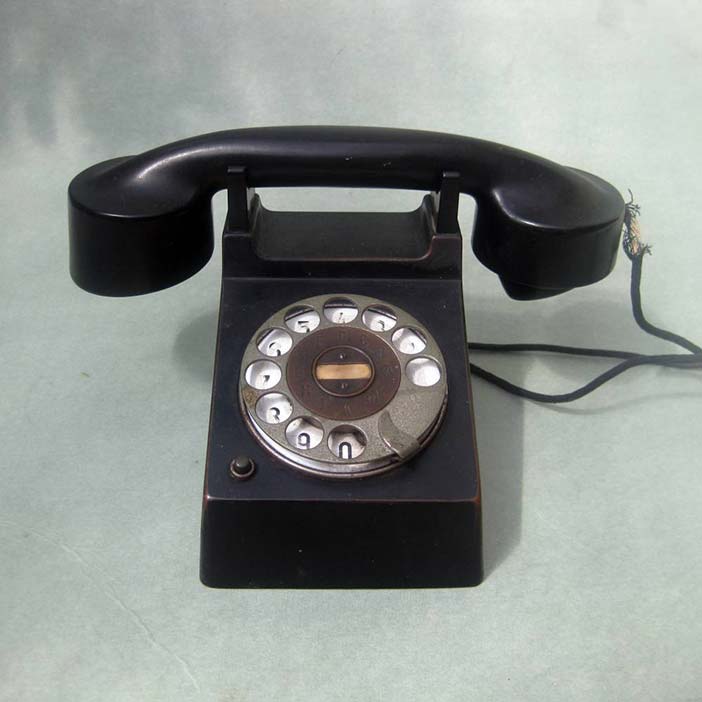
Author/Copyright holder: Courtesy of Christos Vittoratos. Copyright terms and licence: CC-Att-SA-3 (Creative Commons Attribution-ShareAlike 3.0).
Figure 6.3: Telephone 'Frankfurt' produced from 1928 by Fuld & Co., also known as the 'Bauhaus telephone'. The shell and handset of the phone was designed by Marcel Breuer, the rest probably by Richard Schadewell.
6.1.5 Streamlining
At the same time, the idolisation of technology, progress and modernity was further effectuated from the 1940s until the beginning of the 1960s by styling products on the basis of symbols of progress, such as cars, aeroplanes and even satellites. Streamlining, originally derived from the shape of a drop of water, was 'the' way to express speed as a metaphor for energy that could liberate the user. It was the opposite of machine purity, and it diverted the attention from the inner workings of the product to its appearance. Thomas Hine (1986) coined the synthetic word 'populuxe' for this era of popular luxury for all.

Author/Copyright holder: Courtesy of Ignacio Icke. Copyright terms and licence: CC-Att-SA-3 (Creative Commons Attribution-ShareAlike 3.0).
Figure 6.4: A Googie (Populuxe) ashtray from about 1950 that does not only serve its purpose, but has risen to the level of decorative art. It was designed by the industrial designer Maurice Ascalon and manufactured by the Pal-Bell Company.
6.1.6 Electronic products
After the fifties, Modernism faded out in the West (Kint, 2001; Kint et al, 2010). Rationalism, objectivity, universalism and the application of technology and science to human needs and necessities were substituted by replaceability and consumerism. Without unifying ideologies, design got lost in 'prettiness'. Designers were focusing more and more on the 'package' and appearance of the product. Innovation became more popular than invention, and the professions of the designer and the engineer grew further and further apart, especially during the last decades of the twentieth century (Sparke, 1986). The development of technology intensified; the size of the microchip decreased and, simultaneously, its possibilities increased. The technology push spurred on the functionality of appliances, thus offering the user unlimited possibilities and an enormous supply of electronic and digital products. Consumption and personal self-fulfilment were strengthened, and the gap between machinery and commodity increased (Hummels, 2000).
Industrial design missed out on this major industrial development; designers missed the electronic boat, more specifically 'the interaction with the ungraspable'. The design of the physical form and the design of the interface of interactive products were separated. People working within the Human Computer Interaction (HCI) community such as usability engineers did the engineering and interaction thinking, and industrial designers were invited to beautify the new machines (Frens, 2006). They did this by expressing power, rationality, functionality and self-interest. The products were based on 'cognitive' interaction with displays and dozens of neatly organised buttons, as can be seen in, for example, the microwaves, telephones, business equipment, medical equipment, computers and photo and video equipment from the 1980s and 1990s.
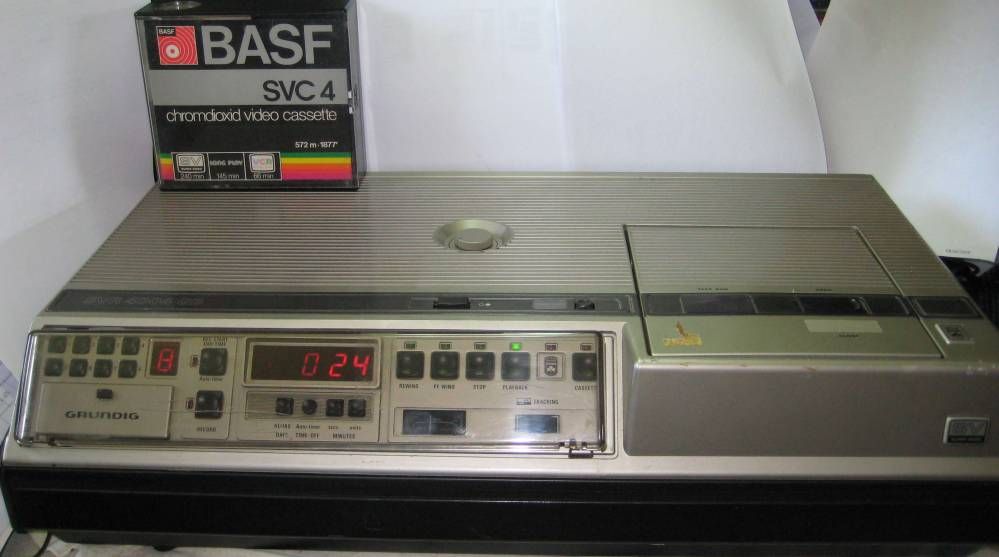
Author/Copyright holder: Courtesy of Colin99. Copyright terms and licence: CC-Att-SA-3 (Creative Commons Attribution-ShareAlike 3.0).
Figure 6.5: A Grundig SVR format video recorder from about 1980.
6.1.7 Towards emotion and experience
In the 1980s, the post-modernist movement Il Nuovo Design, including the companies Studio Alchymia and Memphis, criticised this focus and approach. They advocated concepts such as diversity, discontinuity, eclecticism, ornaments, colour and experience in order to create a more enjoyable and fancy world (Horn, 1985). The adage 'less is more' was replaced by 'less is a bore'. Around the turn of the century, a weakened version of their ideas rapidly caught on in commercial appliances, such as Alessi kitchen appliances, Swatch watches and Apple's colourful iMac, and quickly seemed to turn towards a superficial form of fun and emotions, i.e. 'funnying' the look of products, which we could call 'form follows frivolity' (Hummels, 2000). Around the same time Bauhaus-like objects were reproduced for the elite, becoming terribly expensive and sold in 'design boutiques'. Architects were assembling workers' living units into skyscrapers in the US. Design became exclusive.
The shift towards fun, emotion and experience was also a result of the socio-cultural setting and the economic strategies of companies to survive. Companies introduced lifestyle brands to compensate for the loss of ideals, identity, belief systems and cultural references after the decay of Modernism. By adopting a brand lifestyle of one's choice, people found a way to regain a sense of identity (Brand and Rocchi, 2011). Designers helped to fuel consumption by repeatedly renewing the style of products, of which Swatch is a clear example. And they focused on brands and brand identity by designing the complete package, including machinery and commodity, appearance, services, 'experience', points of sale, advertisements, etc., such as Nespresso and Apple. Designers tried to envision the future through novel concepts, such as Philips' 'Vision of the Future' (1996), although many of those design concepts took the underlying computer logic and cognitive structures as given.
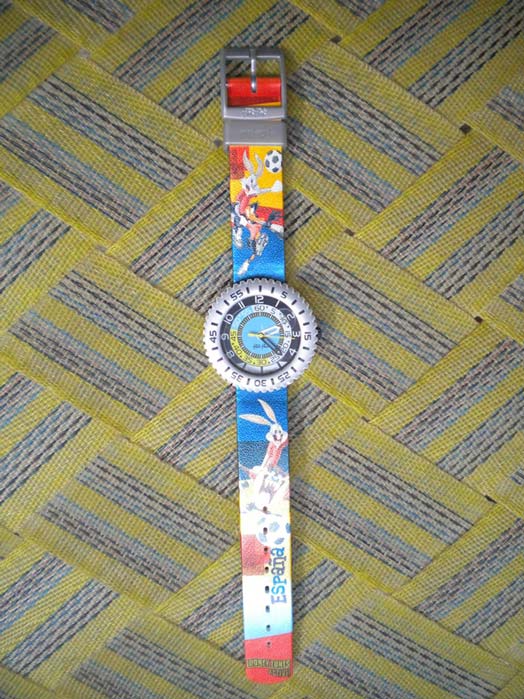
Author/Copyright holder: Courtesy of Khalid Mahmood. Copyright terms and licence: CC-Att-SA-3 (Creative Commons Attribution-ShareAlike 3.0).
Figure 6.6: Funnying: Swatch Flik Flak Fifa World Cup Spain, 1982 The watch shows the time 2:22:16. The lower wristband says 'Looney Toons Active!' and 'Espana', and the wrist bands show Bugs Bunny, Daffy Duck, and the Tasmanian Devil playing soccer.
6.1.8 Knowledge economy
With the move into the twenty-first century, we are shifting from an experience economy to a knowledge economy. People no longer have to rely on brands and product lifestyle to signify and create their identity; instead they are nowadays able to create their own identity or identities through a variety of social platforms, such as Facebook and Twitter (Brand and Rocchi, 2011). We are becoming more and more digital and networked, which influences the profession of the industrial designer.
6.1.9 Reuniting HCI and industrial design
Today we see that the two worlds of HCI and industrial design are coming together again. HCI people move towards experience, and industrial designers embrace the digital, although one can clearly see their history and thus differences in approach and focus. One sees many HCI people and computer scientists who are seeking to bridge engineering and art, science and art, or the three, as can be seen in Robin Baker's book Designing the future (Baker 1993), or in Hiroshi Ishii's work at MIT MediaLab (http://tangible.media.mit.edu/). Moreover, the digital is often a starting point to connect to the real, e.g. with Ishii's Radical Atoms, and a cognitive approach towards experience is still dominant. One generally sees the engineering paradigm in this way of working and thinking based on externalising knowledge, changing the world and taking the machine perspective (Bartneck and Rauterberg, 2007), although the latter is more and more combined with a human perspective.
Industrial designers, on the other hand, tend to base their way of working and thinking on internal knowledge (often referred to as intuition), on changing the world and on a human perspective (Bartneck and Rauterberg, 2007). Contemporary industrial designers are trying to find a way to connect the possibilities of new technology, intelligence and social platforms to people's being in a physical and social world; to map the discreteness of the digital to the continuity of us being in the world. Moreover, industrial designers are exploring their new role in the upcoming transformation economy paradigm in which value is created in communities, by addressing societal issues together on a local scale with all the stakeholders involved (Brand and Rocchi, 2011). For example, RED, a 'do tank' that uses innovative design to tackle social and economic issues, which was set up by the British Design Council in 2004, is one of the initiatives to find new ways (Burns et al, 2006).
6.1.10 Reflections on this short history of industrial design
This short introduction to industrial design may give rise to the misconception that industrial design is only concerned with beauty, especially since traditionally design is taught in art schools (RCA, Design Academy Eindhoven, Design School CMU, Domus Academy). However, this is not the case. From the very early days, industrial design has been involved in emancipatory movements. For example, the German school Bauhaus, which operated from 1919 to 1933, was part of the socialist ideal of creating a 'new man' by ameliorating his environment. The slums should be replaced by houses that let in air and light; the furniture should be easy to produce and cheap to buy by using the latest in production techniques. The same went for cutlery and china. Beauty was an essential part of this endeavour, but not its aim. Industrial design gave direction to cultural developments. Beauty is defined in a context of transformation.
The reader might also have the misconception that all industrial designers are alike in their approach and focus. Although the education of industrial designers has strong similarities all over the world, at least two distinct approaches have arisen in design schools over the last half century. In both approaches young people were and still are trained for a few years in a design school to enter the profession. Mostly this is done, literally, according to the master-bachelor model. The master teaches the pupil by example in studios and workshops. At the end, the pupil produces a 'masterpiece' as a proof of the acquired skills and insights.
Based on this master-bachelor model, one approach emphasised the designer's artistic calling and withdrew into conceptual thinking based on 'intuition'. Another approach looked at science and wanted to become scientific, based on 'rationalism'. The problem is, however, that there are very few designers who are interested in science. They are professionals: why bother about science? This is of course too general a statement, but practice shows that these two worlds are often difficult to merge, although new design schools that aim at merging these directions have arisen and are currently arising, such as the department of Industrial Design at the Eindhoven University of Technology.
In the remainder of this chapter, we briefly sketch the value of integrating design theory and practice for the industrial design profession. We elucidate a few theories from psychology, philosophy and learning which have entered the design profession. We conclude the chapter with our own principles regarding industrial / interaction / intelligent design that are based on these theories, and we illustrate these principles with several design projects.
6.2 The essence of industrial design: integration of theory and practice
One of the authors of this chapter, Kees Overbeeke, came from a scientific approach to industrial design and was not a designer.
My first contact with design taught me a lot. A designer asked me, 'Do you see that line in that car?' I just said, 'What line?' For me a line is something you draw with a pen on a surface. So, there was no line on the car.
As is evident, it may be difficult for a person from academia to understand the mindset of industrial designers. One of the reasons that industrial design, and the mindset of designers, is difficult to understand is that industrial design is essentially about integration.
6.2.1 Integration
Let us use an analogy to clarify what is meant by integration. Take medicine. Medicine is about the integration of knowledge from several established disciplines into practice. But no medical doctor is a specialist in any of the sciences involved. A family doctor has to know a lot, but essentially learns his profession by practising it. He has to acquire a 'feeling' for what may be wrong with the patient based on his knowledge and experience, and act accordingly. The same may be said of a designer. He has to know about materials, about beauty, about people, about culture, about business, about new technology, etc., and act accordingly. Again, the designer is no specialist in any of these fields, but knows how to combine them to create new opportunities.
There is one essential difference, though. The doctor tries to restore the old condition of the patient to make the patient better again. The designer creates something new, something that does not yet exist, and in doing so aims to make a better world. This is an important difference as the designer — as such — is not a 'problem solver'. Designers typically do not solve problems; they go one step beyond and create a new reality for people to explore. The designer as problem-solver is a popular misconception.
6.2.2 Knowledge that is relevant for practice
Now, how can science contribute to the profession of the industrial designer? There is a tendency to 'academise' all professions. That is a very good thing. Medicine really advanced once research into diseases took off. The scientific knowledge established by medical research centres is the direct reason that most of the readers of this text are alive today. At the same time, the family doctor has not lost his importance, nor has knowledge based on experience and intuition.
So, the challenge to academics is to establish a way to provide the practitioner with knowledge that he can effectively use in his practice while respecting his being-a-designer. There does not seem to be any correct or established way to do this, but we, the authors and their group, have enthusiastically tried for the last 25 years. We believe the criterion for success of people working on the research side of industrial design, i.e. academics, should be relevance for professionals (as opposed to relevance for other academics). Such criteria are, for example, 'How many designers use your methods?' or 'How many products using your insights are on the market?' We do not claim that we have the right answers, or that our approaches are the only ways of doing things. However, we have first-hand experience of practising and researching design as a discipline, which is for us the essence of industrial design: integration of theory and practice.
6.3 Theoretical underpinnings for industrial design
Research cannot progress unless it is able to stand on the shoulders of giants. When we started our academic work, about 20 years ago, our aim was to regain control over the whole product design, its context and the way it enriched our lives as individual and social beings (for an overview see Overbeeke and Wensveen, 2003; Djajadiningrat et al, 2004; Hummels et al, 2007; Overbeeke, 2007; Hummels, 2012). We searched for basic principles and theories to unify our endeavour and found two theoretical frameworks from philosophy and psychology and several closely related theories that inspired us to develop the field of industrial design. We will explain these briefly in this part. Moreover, in Part Four we elucidate several other theories that are closely connected to the design projects we illustrate there.
6.3.1 Phenomenology, pragmatism and embodied interaction
The case for a philosophical underpinning of (interaction) design has been masterly made by Paul Dourish (2001) in his wide-ranging book about embodied interaction, starting from the European philosophical tradition. As we are not philosophers, we will be brief here. There is a long-standing tradition of dualism (object-subject) in the West. The best-known example is Descartes' ontology: " je pense, donc je suis." Being is thinking. The phenomenologists in Europe (e.g., Merleau-Ponty, 1958) and the pragmatists in the USA (e.g., Dewey, 1997) reacted against this dualism in the first half of the last century. Dualism seems to imply that the transcendent 'mind' is superior to the body, which is somehow ordered by the mind to act (Overbeeke et al, 2006).
Merleau-Ponty started from the fact that we have a lived (in the sense of experiential) and existential body. We do not have to prove that we exist. We cannot escape the fact. The body has a primacy: it is the way we are in the world. Or as Merleau-Ponty describes it: "être au monde", which means not only being in the world but also belonging to it, having a relationship with it, interacting with it, perceiving it in all dimensions. Perceiving is an activity, and our body and skills are an inextricable part of our perception. We perceive the world in terms of what we can do with it, and by physically interacting with it, we access and express this meaning. Perception, through action, precedes cognition: reflection is a consequence of action. Moreover, we do not perceive ourselves as one more object in the world; we perceive ourselves as the point of view from which we perceive other objects (Merleau-Ponty, 1958; Trotto et al, 2011).
The fact that the body has inherence in the world, and that bodily experience pres our reflective capacities, is overlooked, even neglected, in most philosophies. That is why phenomenologists and pragmatists emphasise the, partly, embodied origin of knowledge, i.e., as reflection upon action. Donald Schön (1983) showed that this concept of 'reflection on and in action' was the core of design practice.
Theories like Embodied Interaction coined by Paul Dourish (2001) and related fields such as Tangible Interaction made the philosophy of phenomenology and pragmatism popular within interaction design. However, as soon as these theories were adopted by a large group of designers and HCI people, the subtlety and strength of Merleau-Ponty and Dewey's underpinnings was often strongly diluted, as is the case with 'affordances', a concept we will explain in the next section.
6.3.2 Ecological perception theory
Perception theory, within psychology, has always been a special field of study: it is ultimately about meaning. The field is strongly interwoven with design, e.g. through the impact of Gestalt theory on the Bauhaus Design School, and it is also strongly interwoven with HCI through mentalism and a cognitive approach to perception (Overbeeke et al, 2006).
We believe that one particular perception theory is of great value for design; one that is closely related to phenomenology. Gibson's theory of perception seems to be a natural ally for designers as it is a functional theory (Gibson, 1979). He is not only interested in how we perceive, but also at the same time in why we perceive. Gibson states that we perceive the world as essentially meaningful because we are 'fit' for the world through our action possibilities. We perceive the world in terms of what we can do with it, i.e., in terms of the action possibilities of our bodies; the functionality of the world reveals itself through manipulating the world, in interaction. This is useful for designers since meaning is put back into the level of action. And designers like that. It is very difficult to design for abstract meaning.
Two important concepts within Gibson's theory are affordances and effectivities. The essential notion of his theory is that we perceive the world in terms of what we can do with it. A person can perceive a surface as walkable (affordances) because he has feet and legs that can move (effectivities). For a fly, the ceiling is walkable because the fly has different effectivities, i.e., a different body. Similarly, a skater can perceive a surface or object as jumpable if he has the proper body, skills, speed and guts.
This approach, and more specifically affordances, has been introduced to design by Donald Norman (1988) and the present authors (Smets et al, 1988; Smets and Overbeeke, 1994). It now has a large following because it is about how we can design for doing, for acting. However, we do not agree with the misconception and simplification that an affordance is a physical characteristic of an object or the environment. We share Sanders' opinion that Gibson's brilliance was the unity of subject and object, which naturally includes one's intentions and every action that a specific organism is able to perform (Sanders, 1997; Michaels and Carello, 1981) .
Nor do we agree with the sometimes mechanistic interpretation of affordances. In 2000, Djajadiningrat, Overbeeke and Wensveen wrote:
We lament this clinical interpretation of affordance. People are not invited to act only because a design fits their physical measurements. They can also be attracted to act, even irresistibly so, through the expectation of beauty of interaction.
— Djajadiningrat et al, 2000
6.3.3 Craftsmanship, reflective practice and constructivist learning
Related to and embedded in phenomenology, pragmatism and the ecological theory of perception, we find a variety of theories a few of which we briefly address here. Others can be found in Part Four of this chapter and in, e.g. Hummels and Frens (2011).
At the crossroads of design and phenomenology, one finds the concept of craftsmanship. Richard Sennett (2008) unravels this phenomenon in his book The Craftsman, which gives a theoretical foundation and understanding of the core of professions such as design, including the designerly attitude and approach. In short, designing is about having a desire to do good work for its own sake. It is about trusting your senses, intuition, creativity, curiosity, imagination and skills to make (synthesise and concretise) and reciprocally to think (analyse and abstract). Designing is about localising (making a matter concrete), questioning (reflecting on its quality) and opening up (expanding its sense), and designers prefer ambiguity, uncertainty, open-endedness, complexity, resistance and they dare to fail. It is a vocation and an obsession (Sennett, 2008). Or one can say, designing is a way of living.
In terms of learning theories, we believe that designers develop and grow according to a learning model that follows an equilibrium — disequilibrium — re-equilibrium pattern (Piaget, 1971), where one goes from one stable state to another by way of disequilibrium, which is often chaos, through which one reaches order. Disequilibrium is the driving force of changing behaviour and development. Reflection and action are essential elements to regain order because they can change personal structures and ways of looking at the world and dealing with it (Doll, 1986). This fits Schön's reflective practice and Dewey's pragmatism, which are both based on the ability of professionals to know, reflect and learn in and through action; to learn by doing and through reflection gains an understanding that arises from experience (Schön, 1983; Dewey, 1997). So, designing is about jumping in, getting your hands dirty and learning from experience. Designing is rooted in a first person perspective and intermittently uses a third person perspective. Consequently, designers need to trust their intuition, use their common sense and dare to make mistakes, or as Schön puts it, by entering into an experience, without judgment, responding to surprises through reflection, we can learn from our actions. And as Merleau-Ponty (1962) states, perception, through action, precedes cognition: reflection is a consequence of action.
Due to the strong emphasis within design on learning by doing and reflection on action, a constructivist perspective on learning is prominent in the design field. The individual or cognitive variants of the constructivist paradigm assume the locus of knowledge construction to be in the individual learner; the social or situative variants assume this locus to be in socially organised networks (Birenbaum, 2003). Common to both perspectives, however, is the notion of activity: it is the learner who creates meaning, affected by and reflecting his socio-cultural environment. Constructivism is about learning and performing through practical application; that is, learning by doing, while simultaneously acquiring theoretical skills and building knowledge. Design programmes based on constructivism use the making skills of the designer as well as his analytical skills to gain knowledge (Hummels and Vinke, 2009). It is a unity of theory and practice, where experience plays a crucial role (Dewey 1938).
Design schools that use an approach to emphasise artistic calling and conceptual thinking based on 'intuition' generally fit in with a constructivist approach. Most design schools that moved towards science turned away from a constructivist approach, although one sees a change in new design schools such as our own department of Industrial Design at the Eindhoven University of Technology, which uses a self-directed, continuous and competency-based learning model (for more information, see Hummels and Vinke, 2009).
6.3.4 Pragmatic aesthetics and aesthetics of interaction
We conclude this discussion of theoretical underpinnings for industrial design with aesthetics, which have always been a core element of industrial design, especially the aesthetic aspects of the artefacts themselves. However, due to the rise in the development of interactive products, the aesthetics of interactive systems have shown a growing interest on top of the aesthetics of the artefacts themselves. Petersen et al (2004) point out that these two approaches to the aesthetics of design reflect Richard Shusterman's (2000) distinction between pragmatic aesthetics and analytical aesthetics respectively. From an analytic perspective, aesthetics arise as a product property. The focus of the design process here is on the aesthetics of appearance, on the creation of artefacts that are attractive and pleasurable to use. The pragmatic approach, on the other hand, is concerned with the aesthetics of use. According to this view, the aesthetics of an artefact emerge out of a dynamic interaction between a user and an interactive system resulting in what has been labelled 'aesthetic interaction' or 'resonant interaction' (Locher et al, 2010). According to Djajadiningrat et al (2007), different directions to aesthetics can be found within the pragmatic aesthetics approach, such as aesthetics of narrative (Dunne and Raby, 2001), aesthetics of actions (Buur et al, 2004), reactive graphics and computational aesthetics (Maeda, 1999) and semantics of movement of products (Kyffin et al, 2005).
Pragmatic aesthetics are gaining momentum nowadays with designers moving towards the digital and the HCI community moving towards experience, and many publications, including our own, have appeared in this field: Djajadiningrat et al (2007); Forlizzi and Battarbee (2004); Overbeeke et al (2002); Petersen et al (2004); Hummels and Overbeeke (2010) and Hummels (2007).
6.4 Accumulated principles of industrial design
Over the last 25 years, we, the authors, have been inspired by the philosophical views of the world described above. Consequently, we have formulated a set of 'principles' or 'beliefs' about design and design research that sum up our views on, and accumulated experiences with, design research. In this part, we explain these principles and illustrate them through examples.
Being in the world
The primacy of action
Reflection on action
Design methods
Intuition and common sense
First / third person perspective
Creating opportunities for transformation through subtlety
6.4.1 Principle 1. Being in the world
Industrial design is about people. It is about our lives, our hopes and dreams, our loneliness and joy, our sense of beauty and justice, about the social and the good. It is about being in the world.
6.4.1.1 Example: Ethics and aesthetics in intelligent product and system design
Designed by: Philip Ross (PhD TU/e)
Project team: Kees Overbeeke, Loe Feijs, Stephan Wensveen, Tom Djajadiningrat and Caroline Hummels (TU/e)
Time frame: 2004-2008
Video: http://www.idemployee.id.tue.nl/p.r.ross/thesis/
There is more to a product than its primary functionality alone. Take for example the mobile phone. It has a primary function. But it is more than just a product that opens an audio link to a person at another location. It offers an expression of a brand and a lifestyle. But it is also more than simply an object that expresses a 'lifestyle' through its styling. This work revolves around a third way of viewing the technologies we use — in terms of how they change our behaviour and the way we experience the world. See for example how the use of mobile phones has changed the way people manage their social relationships.
New technological developments allow for new kinds of change in behaviour and experience. Visions such as Ambient Intelligence sketch a future of intelligent products and systems that are embedded in the everyday environment: "weaving into everyday life until they are indistinguishable from it" (Weiser, 1991). Such omnipresent products and systems will bring about profound changes in our behaviour and experience. This new technological context gives industrial design the opportunity, but also the responsibility, to consider how to give these changes a desirable direction. This raises an ethical dimension of design of intelligent products and systems: what is a desirable change?
The work of Philip Ross (2008) investigates how to design Ambient Intelligent products and systems, taking into account this ethical dimension. His work explores how to design for the ethical dimension of products as well as for 'Aesthetic Interaction', which is a term that relates to beauty that encompasses the dynamics of human behaviour (see Part Three: Theoretical underpinning for industrial design). This is based on the Aristotelian notion of beauty, to kalon, viewing ethics and aesthetics as inextricably linked. So the question is how to design intelligent products and systems that invite people to change their behaviour in a specific way, through incorporating specific aesthetics in the interaction design. In other words, how can we make specific behaviour in the interaction with a product or system so attractive that people are enticed to engage in it?

Author/Copyright holder: Unknown (pending investigation). Copyright terms and licence: Unknown (pending investigation). See section "Exceptions" in the copyright terms below.
Figure 6.7: Philip Ross using his intelligent reading lamp AEI
Philip developed the intelligent lamp AEI to explore how to design a product dynamic form that has a specific effect at the person value level. AEI has three sets of behaviour targeting the values Helpful, Social Power and Creativity, i.e. the light pattern of AEI behaves and reacts to the user's actions in such a way that it aims at the user feeling helpful, creative or having social power (see these videos).
In order to be able to do this, the lamp has capacitive sensors placed beneath the porcelain outer shell to sense the position of the hand, and it has a small camera inside to detect and follow objects in front of the lamp. Moreover, it has an array of 48 high power LEDs that comprise the light actuator. AEI has been further developed over recent years and is currently commercially available as Fonckel, which has less emphasis on these three values, but is aiming at personalised, adaptive interaction to fit user initiated values (www.fonckel.com).

Author/Copyright holder: Unknown (pending investigation). Copyright terms and licence: Unknown (pending investigation). See section "Exceptions" in the copyright terms below.
Figure 6.8: The intelligent reading lamp 'Fonckel' is commercially available
Since to kalon in intelligent product and system design is fairly new, it also requires new methods and techniques, as will be further discussed in design principle 4 'design methods'. AEI could not have been designed in conjunction with similar design techniques such as 'Interaction Quality Framework' and the 'Perspectives model of behaviour in interaction' (Ross, 2008).
6.4.1.2 Related themes and research: 'being in the world'
Philip Ross used the Human Value Theory of Shalom Schwartz (1992, 2004) to describe and measure people's ethical beliefs and the ethical implications of behaviour. During the last century, several disciplines emerged that studied the relationship between products and society, including ethical implications, such as the sociology of technology (Bijker and Law, 1992), the philosophy of technology (Heidegger, 1962; Achterhuis, 1997) and design history (Forty, 1986). Designers are not sociologists, philosophers or historians; they create and build intentional technology. We support Peter-Paul Verbeek's notion that "the ethics of engineering design should take more seriously the moral charge of technological products and rethink the moral responsibility of designers accordingly" (Verbeek, 2006). Therefore, we explain the concept of technological mediation to support designers taking this responsibility.
Technological mediation concerns the role of technology in human action (conceived as the ways in which human beings are present in their world) and human experience (conceived as the ways in which their world is present to them).
— Verbeek, 2006: p. 363
As Verbeek states in the quote above, technology has a mediating role and influences how people interact. The implication is that designers are essentially 'doing ethics' implicitly or explicitly through their designs. So how can designers incorporate this dimension into their design process? Verbeek sees two options. The minimum scenario would be to assess if the design has undesirable mediating capacities and try to reduce or eliminate those. The second scenario would be to build in specific forms of mediation that are considered desirable.
Verbeek sees several mechanisms for technological mediation with its two perspectives: (human) action and experience, which we explain briefly.
6.4.2 6.4.1.2.1 Transformation of human action
Human actions are not merely based on people's intentions or the social context in which they live, but also on the mutual influence of people and the material environment. Don Ihde (1990) refers in this case to 'intentionality' of a product and to 'multistability', which indicates that people can use and interpret products differently, depending on the context. James Gibson (1979) introduced the concept of 'affordances' which are context- and species-dependent action possibilities, and Bruno Latour (1992) introduced a concept from the film and theatre world; he uses the concept of 'scripts' to describe the influence of an artefact on human actions. For example, a ceramic coffee cup has the script to be washed after use, and a cardboard cup the script of being thrown away. Human action and behaviour have two mechanisms for transformation: invitation and inhibition. Products can enable and invite certain behaviour and inhibit other.
6.4.3 6.4.1.2.2 Transformation of experience
Don Ihde (1990) sees two relationships for mediating human experiences and interpretation of reality.
The first relationship is the embodied relationship in which the technological artefact becomes an extension of the human body. Heidegger (1927) calls this a 'ready-to-hand' tool that typically withdraws from the user's conscious attention (Coyne and Snodgrass, 1993). For example, when looking through a pair of glasses, one perceives the environment and not the glasses. The opposite of ready-to-hand is present-at-hand in which the product itself becomes the object of attention instead of the task you want to accomplish with the product. For example, a malfunction of a product, e.g. a hammer or a computer, may cause a focus shift from the task, e.g. hammering or browsing the internet to the actual product, e.g. 'What's wrong with it?' In Human-Computer Interaction, the state of being present-to-hand is often referred to as 'transparency of use,' i.e. that the product is so easy to use that its use becomes 'transparent.'
The second relationship is called the hermeneutic relationship in which a person needs to interpret (the information presented by) the designed artefact, as it is a representation of reality. For example, the thermostat represents the actual temperature, so one cannot feel the temperature through a thermostat. Nevertheless, the thermostat supports one in knowing what the temperature is and in regulating it.
When technology mediates our sensory relationship with reality, it transforms what we perceive by amplifying or reducing specific aspects. This transforming capability is called technological intentionality; technological artefacts are not neutral elements, but have intentions and play an active role in the relationship between humans and their world.
6.4.4 6.4.1.2.3 Sensible Alternative
The Sensible Alternative design from Jelle Stienstra clearly shows this mediating role of technology. When looking at contemporary smartphones like the iPhone, there seems to be a dominance of user interfaces based on menu structures and decision trees, albeit more graphic-oriented and gesture-based than traditional PC interfaces. Jelle Stienstra presents the Sensible Alternative, a concept that enables smart-phone users to navigate between applications by accessing action-possibility-dependent and personalised associated applications. A single added touch-sensitive spot on the underside of the smart-phone provides an alternative layer of interaction between man and machine, on top of hierarchical system architectures. Stienstra designed and prototyped this interaction layer that exploits the advantage of the continuous and the discrete powers of man and machine. In his case study, he explores several consequences of a phenomenological approach for designing complex systems, products and related services (Stienstra et al, 2011).
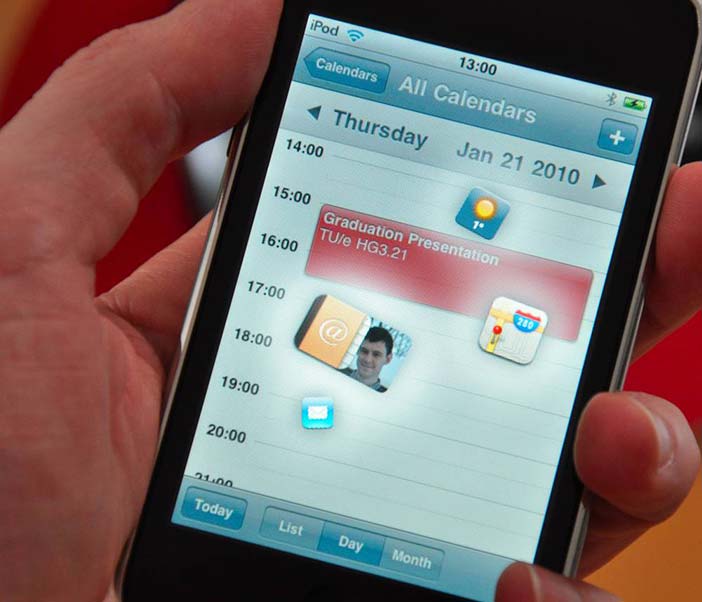
Author/Copyright holder: Unknown (pending investigation). Copyright terms and licence: Unknown (pending investigation). See section "Exceptions" in the copyright terms below.
Figure 6.9: Sensible Alternative by Jelle Stienstra
6.4.5 6.4.1.2.4 Frogger and interactive materiality
Designed products transform people's behaviour, either through the sign character or the materiality of the product. Where often the static materiality of the products was inhibiting or inviting behaviour, interaction design can address the interactivity of the materiality and focus on the dynamics of the product. The exploration of the action- perception loop in a systematic and sensitive way using the Interaction Frogger framework (Wensveen et al, 2004) can inspire designers to transform behaviour in, and through, the interaction with products.
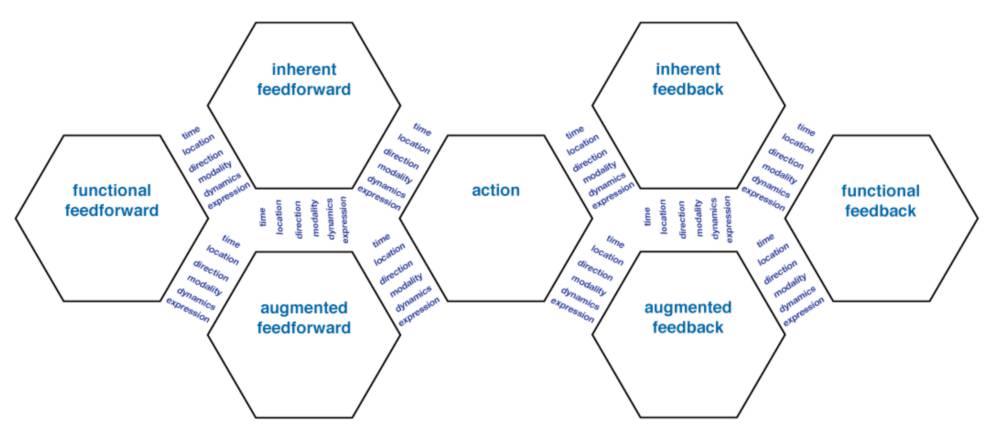
Author/Copyright holder: Unknown (pending investigation). Copyright terms and licence: Unknown (pending investigation). See section "Exceptions" in the copyright terms below.
Figure 6.10: Interaction Frogger framework, showing all theoretically potential mappings between the action and the elements of perception (feedforward and feedback) (Stienstra, Bruns, Wensveen and Kuenen, 2012)
Designers can successfully transform behaviour on both a bodily and emotional level, by interweaving three essential steps in an iterative design process: an analysing step, a synthesis step and a detailing step. The analysing step focuses on gaining affirmation and appreciation by the designer for the current behaviour with a focus on the Interaction Frogger aspects of dynamics and expression. Synthesis focuses on the designing of the mapping within an action-perception loop. Within this step the 'colouring' for a targeted transformation of behaviour is tackled by exploring the six aspects of interactive materiality. Timing and scale related mappings can be applied over the input towards the output in order to amplify or reduce feedback contributing to feedforward and inviting transformation. The detailing step focuses on subtlety in interaction in order to have a ready-to-hand transformation of behaviour, exploiting the perceptual-motor and emotional skills. For this step, the designer should explore and seek boundaries within sensitivities of sensory systems respecting the uniqueness in skills and capabilities of the user. Designing for the transformation of behaviour, focusing on a person's cognitive skills can now also be complemented with an approach that seems a better fit with third-wave HCI; the focus on the bodily and emotional aspects of interaction to transform behaviour (Stienstra et al, 2012).
6.4.6 Principle 2. The primacy of action
In accordance with Dourish's and others' approaches to epistemology, meaning cannot be detached from action. Meaning is in (inter)action. There is a primacy of embodiment.
6.4.6.1 Example: Mustick
Designed by: Joris Zaalberg, Tom van Bergen, Floor Mattheijssen, Wouter Kersteman (Former Master students TU/e)
Project team: Kees Overbeeke and Stephan Wensveen (TU/e)
Time frame: 2008
Video: http://www.joriszaalberg.com/
The Mustick project is a very simple example of embodiment, but a very powerful one. Basically, Mustick is a stick which acts as an on-off switch that makes pre-recorded music play/stop. Once you have it in your hand, you start behaving expressively.
Conceived from a project on embodied interaction, Mustick is a design that allows non-musicians to perform songs of their favourite artists for family and friends at parties and social gatherings. The design uses the expressive powers of the human body to interact with pre-recorded music in meaningful ways. Mustick allows users to manipulate the playback of any song in real-time — simply by moving, shaking and swinging the device. The direct control of musical content creates a dialogue between user and music, turning the listener into a performer.
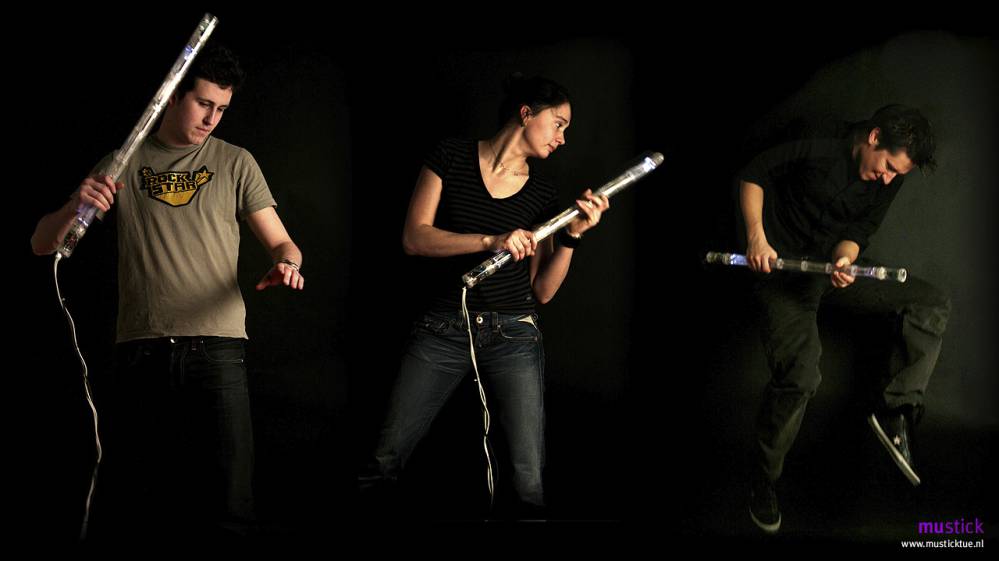
Author/Copyright holder: Unknown (pending investigation). Copyright terms and licence: Unknown (pending investigation). See section "Exceptions" in the copyright terms below.
Figure 6.11: First version of Mustick
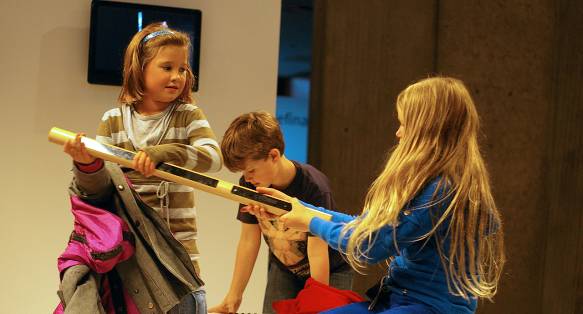
Author/Copyright holder: Unknown (pending investigation). Copyright terms and licence: Unknown (pending investigation). See section "Exceptions" in the copyright terms below.
Figure 6.12: The second wireless version of Mustick
6.4.6.2 Example: DanceRail
Designed by: Erik Toering, Pakwing Man and Frank de Jong (Former Master students TU/e)
Project team: Kees Overbeeke (TU/e), David Kirsch (UCSD), Philip Ross, Caroline Hummels (TU/e)
Time frame: 2009
Video: http://www.dancerail.nl/
The DanceRail project involved a multidisciplinary team consisting of industrial design students from TU/e and Cognitive Science students from University of California, San Diego (UCSD). The goal of the interactive installation is to stimulate people to experience and think about movement with their body. The installation is related to an extensive research into dance creation at UCSD in February 2009 by Professor David Kirsch. His research concerns the new choreography of Wayne McGregor with his dance company Random Dance.
The DanceRail is an installation designed to engage your physical side — to encourage movement in a "dancerly" way. The shape of the rail was derived from an early version of dance phrases for a new choreography by Wayne McGregor. By running your hands over the rail, you will begin to move in non-everyday ways. The light is an enticement to explore and interact with the installation.
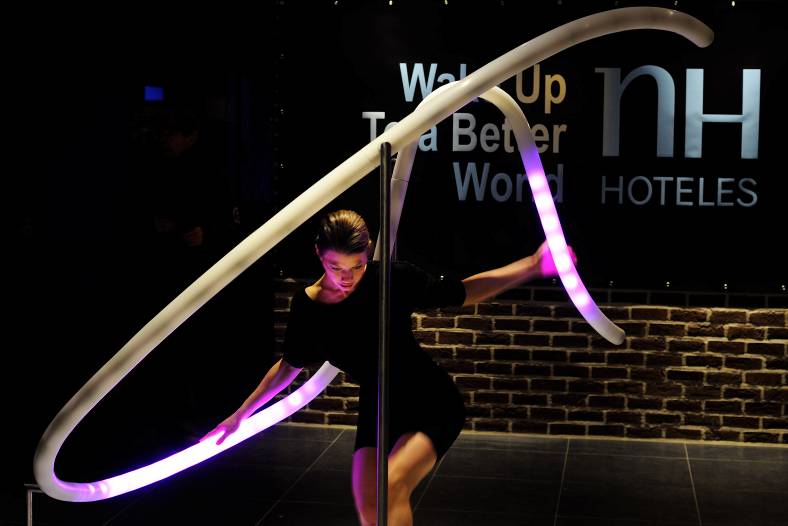
Author/Copyright holder: Unknown (pending investigation). Copyright terms and licence: Unknown (pending investigation). See section "Exceptions" in the copyright terms below.
Figure 6.13: Roos van Berkel interacting with DanceRail
6.4.6.3 Related themes and research: 'the primacy of action'
Ever since the computer entered our daily and social life, it has ceased to be merely a means to perform our work and has become a means to help us pursue our lives. This development has connected the worlds of industrial design (ID) and human computer interaction (HCI), leading to the advent of fields like social computing, tangible interaction and embodied interaction.
Shaer and Hornecker (2010) give an extensive overview of the past, present and future directions of tangible user interfaces (TUIs), which interlink the digital and physical worlds. They explain how TUIs originated from Graspable User Interfaces (Fitzmaurice et al, 1995) and Tangible Bits and Bytes (Ishii and Ullmer, 1997). TUIs have become an established research area, and the word 'tangible' now appears in many calls for papers or conference session titles. Following diverse workshops related to tangible interfaces at different conferences, the first conference fully devoted to tangible interfaces and, more generally, tangible interaction, took place in 2007 in Baton Rouge, Louisiana. Since then, the annual TEI Conference (Tangible, Embedded and Embodied Interaction) serves as a focal point for a diverse community that consists of HCI researchers, technologists, product designers, artists and others (Shaer and Hornecker 2010).
Closely related to the field of tangible and embodied interaction is embodied cognition. David Kirsch, who, as described above, was deeply involved in the development of DanceRail, is strongly embedded in the field of embodied cognition (EC). Embodied Cognition merged in the early 1990s as an explicit reaction to the then standard cognitivist paradigm. Instead of a Cartesian split between mind and body, inner representations versus the outside world, embodied cognition can be found in the corner of Merleau-Ponty and Dewey, by appreciating the body's special status. Within EC several variations can be found, such as distributed cognition and enactment (Dijk, 2012).
6.4.7 Principle 3. Reflection on action
A design theory must be a theory of action and the embodied in the first place, and of meaning in the second, and not the other way around. Reflection on action is the source of knowledge.
6.4.7.1 6
Designed by: Ivo de Boer, Joran van Aart, Bram Braat, Laurens Boer (former Master students TU/e)
Project team: DQI group (TU/e)
Time frame: 2008
Sponsor: Microsoft Research Design Expo
More info: http://dqi.id.tue.nl/docs/Eindhoven_designs_V1.pdf
Sense6 was developed for the Microsoft Research Design Expo, which aims to showcase exceptional design processes and ideas of a small number of universities from all over the world. The theme of the 2008 edition was 'Learning and Education'. The students developed Sense6 during our six weeks Master Design Interaction Class, in which they proceeded from the brief to fully working prototypes using the reflective transformative design process (for the explanation of the RTD process, see related themes and research below). The project used 'reflection on action' on two levels: firstly, Sense6 is a reflective practice platform for skateboarders to develop their skills; secondly, the design process of the design students depended heavily on reflection on action.

Author/Copyright holder: Unknown (pending investigation). Copyright terms and licence: Unknown (pending investigation). See section "Exceptions" in the copyright terms below.
Figure 6.14: Sense6, a platform for learning extreme sports
6.4.8 6.4.3.1.1 Introduction
The Sense6 concept explores non-obtrusive feedback on action through the connection between senses (synaesthesia) to support the 'learning by doing' paradigm. As explained in our theoretical underpinning, learning-by-doing is a key concept within Pragmatism. Sense6 is a sharing platform for skateboarders, in which feedback on action is used not only to improve technique, but also to teach other people about their physical actions without the need to be there themselves.
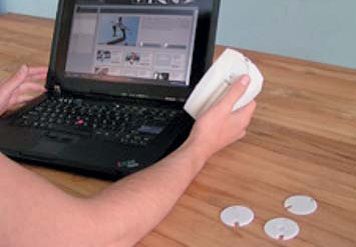
Author/Copyright holder: Unknown (pending investigation). Copyright terms and licence: Unknown (pending investigation). See section "Exceptions" in the copyright terms below.

Author/Copyright holder: Unknown (pending investigation). Copyright terms and licence: Unknown (pending investigation). See section "Exceptions" in the copyright terms below.
Figure 6.15 A-B: A communicator with tokens is used to capture movements and share them online
6.4.9 6.4.3.1.2 Three elements
Sense6 consists of three main parts: 1) an online community, 2) a communicator with tokens and 3) sensor and actuator pads in grip tape and kneepads. The online community supports a platform for sharing skills over the internet. A skill is provided as a package of digital data that gives instruction through sensors and actuators. This data can be downloaded through the communicator to a token which contains the actual skill data.
The same communicator can be attached to the board to communicate the skill data from the token to the sensors and actuators embedded in the grip tape on the board and to the sensors and actuators in kneepads; it also provides the board with power. Light indicators and pressure sensors are embedded in the grip tape, and the kneepads contain bend sensors and vibrating actuators.

Author/Copyright holder: Unknown (pending investigation). Copyright terms and licence: Unknown (pending investigation). See section "Exceptions" in the copyright terms below.
Figure 6.16: Light instructs a person to learn a variety of actions
6.4.10 6.4.3.1.3 Skill data
The skill data provides information about location, balance and action rhythm while skateboarding. The position of the user's feet is first indicated through light. If this is correct, the user continues to the next step where pressure sensors measure the weight distribution and instruction is given by vibration. In the third step, a sound rhythm indicates the rhythm to be copied in the fourth step. Bending the knees and putting pressure on the board create this rhythm. This allows a very rapid movement to be learned by copying.
The skill data does not only apply to learning tricks, but can also be recorded onto a token, which can then be uploaded and exchanged through the community or exchanged in the physical world. By connecting two communicators together, one can copy data from one token to another through these communicators.
6.4.10.1 Related themes and research: 'the primacy of action'
In Part Three of this chapter, Theoretical underpinning of industrial design, we showed the importance of reflection for development. Phenomenology and pragmatism emphasise the, partly, embodied origin of knowledge, i.e., reflection upon action. Merleau-Ponty (1962) states that perception, through action, precedes cognition: reflection is a consequence of action. Professionals like designers have the ability to know, reflect and learn in and through action, to learn by doing, and through reflection gain an understanding that arises from experience (Schön, 1983, Dewey, 1997). Or, as Donald Schön (1983) states, by entering into an experience, without judgment, responding to surprises through reflection, we can learn from our actions. He also showed that this concept of 'reflection on and in action' was the core of design practice.
6.4.11 6.4.3.2.1 Reflective Transformative Design (RTD) process
During these six weeks, the students positioned themselves in the theme of 'learning and education' by means of a transformative design vision in order to find their unique design challenges within a specific context. They went through several hands-on iteration cycles to create and deepen their insight into the design challenge. Moreover, they used co-reflective techniques to validate their proposals in real-world settings with users. In short, they used the Reflective Transformative Design process (RTD process). The RTD process is especially created to support designing disruptive innovative products and intelligent, open systems (Hummels and Frens, 2008; Hummels and Frens, 2011).
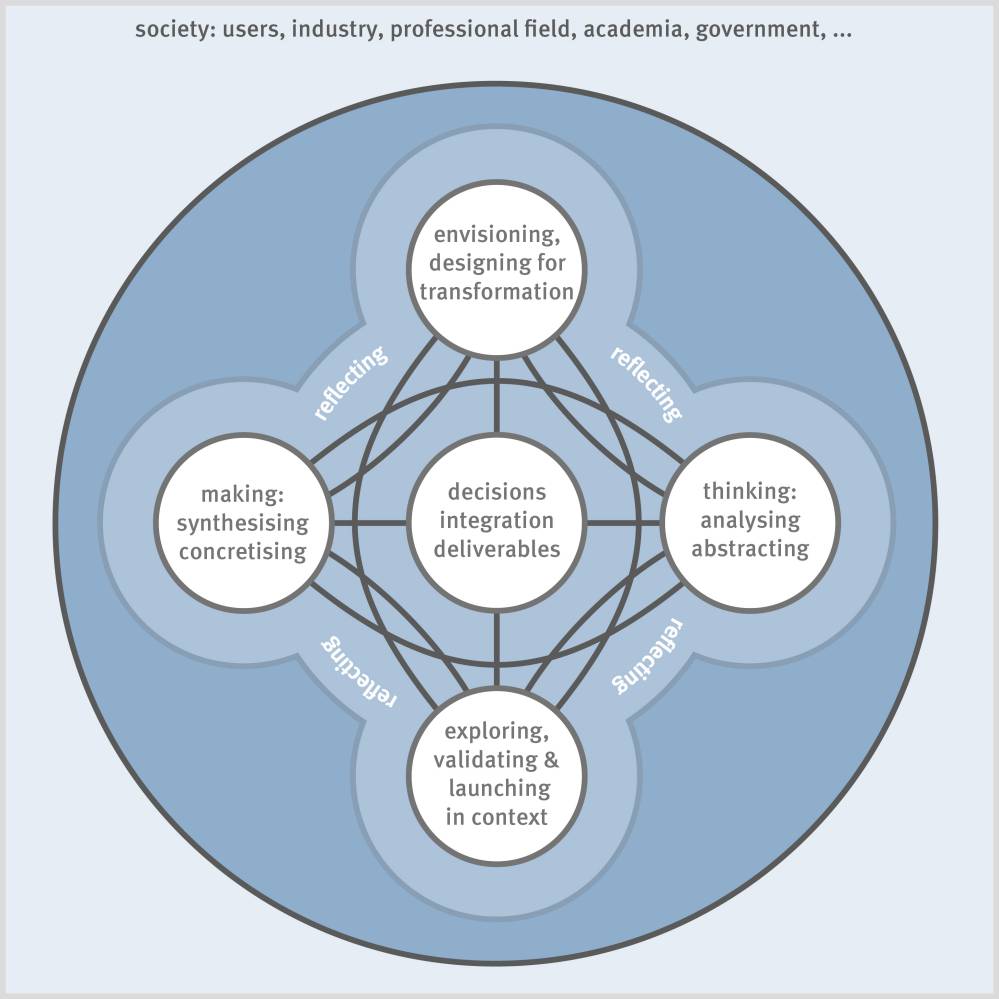
Author/Copyright holder: Unknown (pending investigation). Copyright terms and licence: Unknown (pending investigation). See section "Exceptions" in the copyright terms below.
Figure 6.17: The Reflective Transformative Design process
Developing design solutions, which is placed in the centre of this model, can be seen as a process of taking decisions based on too little information. These decisions are always conditional and can change over time based on the available information and actions taken.
The RTD process knows two axes: vertically we distinguish drives, and horizontally we distinguish strategies for information gathering to direct design decisions. The first drive is information gathering to direct the design decisions through the designer's vision (top circle), and the second drive is information gathering to explore and validate design decisions in the everyday living context of and with users, even beyond launching the system, product and services in the market (bottom circle). The drives are incorporated within two strategies that generate information and that reciprocally provide focus for each other. The first strategy revolves around design action, both synthesising and concretising, such as building an experienceable prototype (left circle). The second strategy revolves around academic thinking: analysis and abstraction (right circle).
Dependent on the person, context, or phase within the design process, designers determine where they start and the order of the activities. This way, the process supports flexibility, diversity and individuality, and it can even enhance chaos, moving from disequilibrium to re-equilibrium. The designers also determine how often they switch from one activity to another, although a high pace is recommended, especially during the early phases of the design process, but also during the later phases since this enables the designer to get a fast and good insight into what is happening within interaction in a diverse social context and market.
6.4.12 Principle 4. Design methods
Methods used in a design process must be rooted in design practice, in the socio-cultural and multi-cultural environment, invigorated by experimental and technological methods from other disciplines.
6.4.12.1 Example: Light Through Culture
Designs by: Master students (TU/e and University of Siena)
Project team: Kees Overbeeke (TU/e), Patrizia Marti (UoS), Rombout Frieling, Remco Magielse, Richard Appleby, Caroline Hummels (TU/e)
Time frame: 2011
Sponsors: University of Siena, Erasmus, ILI/OpenLight
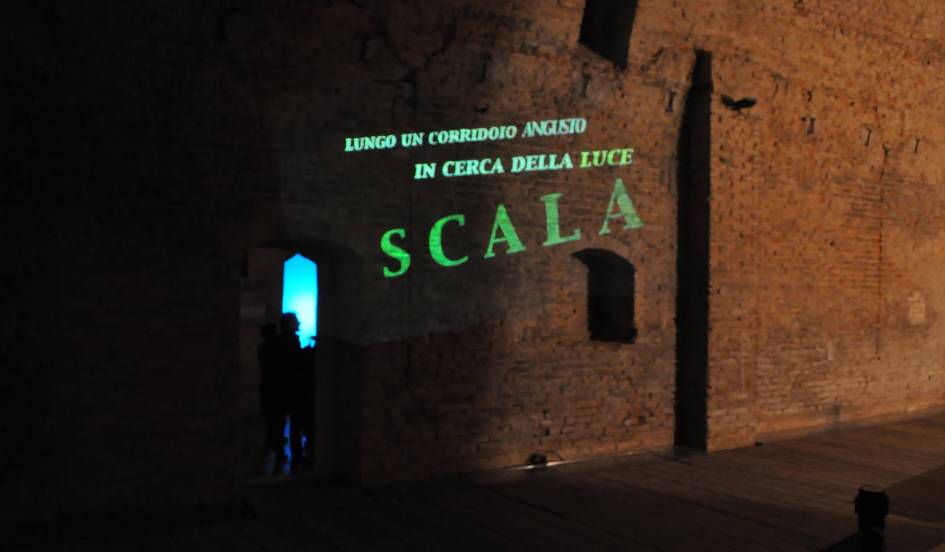
Author/Copyright holder: Unknown (pending investigation). Copyright terms and licence: Unknown (pending investigation). See section "Exceptions" in the copyright terms below
Figure 6.18: The pilgrimage route based on light in the Museum Complex Santa Maria della Scala
Light Through Culture is an international design school which explores the theme of complexity in learning environments. The aim of the school is to weave the newest technologies and the rich existing culture into a new canvas for making and thinking. Learning is meant as a way to (re-)incorporate culture and making into thinking. The school is hosted by the Museum Complex Santa Maria della Scala in Siena, Italy.
The historical backdrop of the project was Via Francigena, the ancient pilgrimage route established in the Middle Ages from Canterbury to Rome, thus passing through England, France, Switzerland and Italy. Travelling along the route, the pilgrims stopped at the hospital of Santa Maria della Scala, where they could be given shelter and care on their way. Pilgrims started a long trip towards the enlightenment, the hope, the alleviation.
Being immersed in this rich historical-cultural context, the project participants were asked to design an experiential path in the underground museum where it intersects with the ancient Via Francigena. The design school tried to answer the question as if contemporary museum visitors were new pilgrims. This was done by exploring history and culture by means of innovative light technologies. Learning developed while building a real path in the underground museum. At the end of two weeks the pilgrimage experience was offered to hundreds of visitors, based on a route through four spaces (see film; Marti and Overbeeke, 2011):
Scala: "The road that seems easy might lead us nowhere."
Finestra: "Life has a certain end but there is hope."
Carnaio: "Life is cruel, how can we go on? The words comfort us."
Lavatoio: "Life is purifying. Water will purify us, and we are innocent again."
Opening the results of the design activity to the experience of real visitors and reflecting on how people feel, perceive and make sense of their experience is a strong means of learning to become a designer. Learning confronts you with the whole complexity of a real environment: the results of the school were not only texts, but also physical, virtual and mixed new realities consisting of new ways of presenting and adding new dimensionalities to the existing world.
6.4.12.2 Related themes and research: 'design methods'
Design researchers are continuously confronted with the challenge ' how to design for ...' Which process or method is appropriate for design research? Within the DQI group, we strongly believe in the strength of Research-through-Design (RtD) And since there is no uniform definition, we briefly explain what we mean by Research-through-Design.
Often RtD is associated with Bruce Archer's 'research through practice' (Archer, 1995), which can be seen as a process in which scientific knowledge is generated through consequent cycles of designing, building, and experimentally testing experiential prototypes in real-life settings. This implicates that RtD aims at studying an effect in a possible future, instead of understanding the world, as is the objective of traditional science (Stappers, 2007).
Designers are typically operating in a constantly changing context which can never be accurately modelled (Wakkary, 2005); thus a reductionist approach to addressing this context and situations within would fail (Zimmerman et al, 2007). Consequently, both designers and design researchers have to embrace the richness of a complex design situation, be fully immersed in the context of the case, and act designerly and in a way that is appropriate for the specifics of that situation. This implies developing detailed design prototypes that allow for this diversity, subtlety and richness during their confrontation with the world (Hengeveld, 2011; Stolterman, 2008). Therefore, RtD relies on the generation of wealthy, experienceable prototypes, and an evaluation in situ in a physical, human and experiential sense (Wakkary, 2005) will consequently result in equally contextual scientific results, leading more to conditional regularities than to general laws (Hummels, 2000). The prototype is the physical, experiential manifestation of this; the carrier of integrated, contextualised knowledge, the physicalisation of a design rationale. This means that when the test subject interacts with a prototype, he interacts with the designer-researcher's line of thought. Bart Hengeveld (2011) thus concludes that researcher and designer should be one and the same person.
Research-through-Design is also part of the book about design research that appeared in October 2011: Design research through practice: From the lab, field, and showroom, by Ilpo Koskinen, John Zimmerman, Thomas Binder, Johan Redström and Stephan Wensveen. The book gives a complete overview of how international design research is conducted in some major European and American universities. The authors took on the challenge to write an overview that is theoretically informed, rooted in practice, showing many examples and relevant to both research and practice.

Author/Copyright holder: Morgen Kaufmann Publishers. Copyright terms and licence: All Rights Reserved. Reproduced with permission. See section "Exceptions" in thecopyright terms below.
Figure 6.19: Book cover: Design research through practice
6.4.13 Principle 5. Intuition and common sense
Intuition and common sense are paramount and should be leveraged to the maximum. "Le sens commun n'est pas si commun," Voltaire said, meaning common sense is not so common.
6.4.13.1 Example: LinguaBytes
Designed by: Bart Hengeveld (PhD TU/e) and Riny Voort (Viataal).
Project team: Jan de Moor (Radboud University) Hans van Balkom (Kentalis / PonteM), Caroline Hummels and Kees Overbeeke (TU/e)
Time frame: 2006-2011
Sponsors: Dr. W.M. Phelps-Stichting voor Spastici (main sponsor), Stichting VSB-Fonds, SKAN Fonds, Nederlandse Stichting voor het Gehandicapte Kind, Nationaal Revalidatie Fonds, Stichting Kinderpostzegels Nederland, Johanna Kinderfonds and Stichting Bio-Kinderrevalidatie
LinguaBytes is an interactive play-and-learning system aimed at stimulating the language development of children with multiple disabilities including minimal or no verbal abilities between the ages of one and four years old (Hengeveld, 2011). The foundations of early language acquisition are laid by early parent-child interaction in the first years of a child's life (Snow and Ferguson, 1977; Tomasello, 2003). When early language development is distorted, as is generally the case with children with multiple disabilities, parent-child interaction does not start or progress normally. Not only does this cause impediments in the child's linguistic skills; it also has repercussions on perceptual-motor, cognitive and emotional skills since the developments of all skills are interdependent at this age.
Augmentative and alternative communication (AAC) is a term that refers to an interaction in which technology is used to enhance the communicative skills of handicapped individuals. It may seem obvious that products for this very young user group (aged one to four) require radically different interfaces than the ones we know from the PC, which is a machine originally designed for office use.

Author/Copyright holder: Carlos Gustavo Curado. Copyright terms and licence: All Rights Reserved. Reproduced with permission. See section "Exceptions" in the copyright terms below.
Figure 6.20: One of the potential user of LinguaBytes demonstrates the inadequacy of the PC, its input and interaction style.
Despite the commercial success of many AAC systems, the products have unfortunately not been given these radically different interfaces . The cognitive load of these systems is high, i.e. most AAC devices are not organised in ways that reflect how young children think (Coker and Shook 2006). Moreover, the current generation of AAC systems are not particularly appealing to young children in comparison with toys (Light et al, 2004). They resemble PCs in structure (menus and decision trees), input (mostly button-like) and output (often screen-based display). Despite the useful endeavour to develop a variety of special input devices for these youngsters, one wonders why young children are placed behind a desktop computer, which was originally designed for office work. Moreover, PCs are typically designed for exclusive use, i.e. one person sitting behind the screen with input devices, which is far from ideal to enhance interaction between parent/therapist and child.
In response to this situation, LinguaBytes challenges multi-handicapped children to capitalise not only on their cognitive and linguistic skills to develop their language and communicative skills, but also on their perceptual-motor and social skills. LinguaBytes is a modular system in which language is offered to children in a physical, playful form. Using a large collection of playful materials, children can read interactive stories and do linguistic exercises, preferably together with a caregiver, therapist or teacher.
LinguaBytes consists of several 'spaces'. The first space is primarily controlled by the child, i.e. using the LinguaBytes play-and-learning materials to interact with stories and exercises. By placing the child in control, LinguaBytes contributes to the child's sense of independence and thus stimulates self-esteem. In the second space, the carer has primary control over the choice and timing of stories and exercises and as such is responsible for giving structure to the child's linguistic development. Additionally, there are two spaces where carer and child either have shared control or joint attention: both can communicate with LinguaBytes' collection of play-and-learning materials and communicate about what they see happening in the interactive stories and exercises, shown on LinguaBytes's output module.

Author/Copyright holder: Unknown (pending investigation). Copyright terms and licence: Unknown (pending investigation). See section "Exceptions" in the copyright terms below.
Figure 6.21: The LinguaBytes system with different exercises.

Author/Copyright holder: Unknown (pending investigation). Copyright terms and licence: Unknown (pending investigation). See section "Exceptions" in the copyright terms below.
Figure 6.22: The LinguaBytes system with different exercises.
Intuition played an important role while designing LinguaBytes, for both the designer-researcher and for the children. The necessity to use this natural character of designers was even amplified because non- or hardly speaking children cannot be involved through regular research methods (e.g. interviews are impossible), but they can and do show the value LinguaBytes has for them through their behaviour. For example, repeated actions, laughing, taking over control and a subtle smile can all be hints to see if a child has understood and liked the exercise. Consequently, the designer, Bart Hengeveld, was often present at the rehabilitation centres to engage with the children and the therapists.
Since Bart had to trust his intuition, he went through a highly iterative research-through-design process, thus exploring a large scope of possibilities with a variety of toddlers and carers. As explained in the previous principle, making these large amounts of concepts and ideas experienceable enabled him to communicate with the children via his designs. And since the children and the therapists interacted with his physicalised design rationale, he could stay close to his intuition. Based on his years of experience as designer, e.g. of toys and interactive systems, his experience informed his intuition.
Nevertheless, he also developed creative methods to trigger his intuition in fields in which he was less experienced, such as the severe motor disabilities of some of these children. For example, by re-contextualising a situation, designers often get ideas that are not always useful, but highly inspiring. And as the obvious solutions will surface anyway, Bart preferred for this challenge to invest in the less obvious ones, which is again a way to trigger intuition. For example, he gave a group of the designers the following exercise, to explore the challenges of children whose movements are involuntary:
Oh dear, you are not in luck: the location where you organise a chess tournament lies at a notorious fault line. Every other minute the whole venue shakes so much that not only the chess pieces topple, but the players as well. It is too late to relocate or cancel. How can you prevent the chess games at the tournament from going to pieces?
— Hengeveld, 2011
But intuition was also essential for the children interacting with LinguaBytes. Given the limitations of their communication skills, the children who use LinguaBytes can only use products that are intuitive and do not need manuals or instruction. LinguaBytes gives importance in two ways to the primacy of action and embodiment, while taking into consideration the perceptual-motor skills of the toddlers (e.g. the restricted motor skills of children with cerebral palsy). Firstly, the system invites certain behaviour: for example, the white trays of the exercise module afford placement of the (white base of the) inputs. The relation in size between tray and the height of the tray, the size of the inputs and their weight all support the child in placing the inputs in the tray. Finding this balance was an iterative process of building many different trays and inputs. Secondly, for children with severe motor limitations, the actual placing of an input is smoothened through subtle and unobtrusive support like physical restrictors such as magnets to 'guide' certain movements.
6.4.13.2 Related themes and research: 'intuition and common sense'
The designer of the LinguaBytes project, Bart Hengeveld, opened up his intuition through his making skills. Firstly, by building a variety of experienceable prototypes, he enabled the toddlers and their carers to have access to and express meaning. In contrast, abstract ideas cannot be experienced or interacted with (perhaps only imaginatively). Secondly, making enabled him to explore the unknown by trusting his senses, exploring resistance and ambiguity and tapping into his intuition. Dijksterhuis and Nordgren (2006) show that intuition, or unconscious thought as they call it, is better suited for dealing with complex matters than conscious thought. Designing, which is based on creating, is the highest form of (cognitive) complexity, according to the Revised Bloom's Taxonomy (Anderson and Krathwohl, 2000).
Intuition is usually not considered as an 'official' modus operandi because using intuition does not contribute to making the process repeatable by others. Yet, because of the complexity of design processes and the intrinsic complexity of users, intuition is an indispensable component in design; it is the tool that empowers us to make choices in the iterations of a design process. Because "intuition begins with the sense that what is not yet could be" (Sennett, 2008, p. 201), it involves skills, as skills are our way to make sense of the world and transform it (see principles 2 and 3). Intuition is necessary to make leaps in the design process, and it is "an imaginative experience ... that guides us towards what we sense is an unknown reality latent with possibility" (Sennett, 2008, p. 213). Therefore, training intuition is essential to become skilled in designing systems and products.
Sennett proposes four stages to enable intuitive leaps: reformatting, adjacency, wonder and gravity (Sennett, 2008, p. 209).
Reformatting is the willingness to see if a tool or practice can be changed in use; it is the abstraction phase. Can we reach the core of what a certain tool or practice is? For example, one of the authors, Caroline Hummels, likes ballroom dancing. When trying to reformat this 'social dance in conventional rhythms', it boils down for her to having the right balance between, on the one hand, letting go, being in flow, 'stepping out of one's body' and floating, and, on the other hand, staying in charge, stretching the entire body, owning the space and being present.
In order for the intuitive leap to take place, the designer uses adjacency. Adjacency occurs when two unlike domains are brought together. Based on her impression of dancing, Caroline started doing sketching exercises with a pencil with the aim of achieving the same feeling as dancing. And she also tried to do it the other way around: drawing while dancing.
Thereupon tacit knowledge is dredged up into consciousness to do the comparing, which can result in surprise. As Sennett reminds us, the word 'wonder' in ancient Greek is embedded in poiein, a word that indicates the act of making, which is also the root-word for poetry. By cross-pollinating dancing and sketching, it turned out to Caroline's surprise that dancing felt lighter when trying to draw the dance with her body...
The last stage of intuition which allows us to see beyond what is there, once again through the use of abstraction, is "recognising that a leap does not defy gravity; unresolved problems remain unresolved in the transfer of skills and practices" (Sennett, 2008, p. 211). Back with two feet on the ground. Although ballroom dancing feels lighter, and she is training twice a week for competitions, the physical limitations are there, and they will frame the progress in lightness.
6.4.14 Principle 6. First / third person perspective
Design practice and design research are powerful generators of knowledge. They are a way of looking at the world and transforming it. This way of looking is rooted in a first person perspective while intermittently taking a third person perspective. Consequently, design relies on connecting the sensorial, intuitive, to the abstract, analytical.
6.4.14.1 Example: Master's Classes 'Designing for points of view' and 'Aesthetics of interaction'
Designs by: Master students (TU/e and Tsukuba University Japan)
Lecturers: Caroline Hummels, Kees Overbeeke, Ambra Trotto and Michael Cruz-Restrepo (TU/e)
Time frame: 2006-2011
In a course, students were asked to investigate deeply the 'design of meaning'. What is important for designers to realise is that meaning construction also occurs during the design process. As we do in all our work, we took phenomenology as a starting point, which implies that designers perceive themselves as the point of view from which they perceive systems and products. Consequently, they are a part of their designs. They are designing from a first person perspective while intermittently taking a third person perspective (Trotto et al, 2011). Within the first person perspective, they are doing in action, reflecting in action and experiencing the situation. Simultaneously, they bring in their own value system and skills. Consequently, their designs will be meaningful for them in a different way from that of someone else. When stepping out towards a third person perspective, they can reflect upon their actions or upon the situation.
In line with the phenomenological approach, the students were asked to design an empowering/enabling tool that would allow a person to experience someone else's skills. To be able to design such a tool, the students went through the different steps of documenting and reflecting upon their own and each other's skills. One group, Yves Florack's, took up snowboarding.

Author/Copyright holder: Unknown (pending investigation). Copyright terms and licence: Unknown (pending investigation). See section "Exceptions" in the copyright terms below.
Figure 6.23: Set-up Master's class 'Designing for points of view'
During the first day, Yves documented in a short video documentary his own skill: snowboarding (1st person perspective).
During the second day, he tried to show and tell Mark at an indoor ski centre what snowboarding meant for him, and Mark translated his impression of Yves's skill into a short video documentary (2nd person perspective).
Mark showed his video to Yves, who used it as a mirror to reflect on his own skill, and subsequently, Yves fine-tuned his first video.
During the third and fourth day, Yves made a cutting tool for Sijme to experience the salient element of snowboarding: moulding and carving of a soft material by means of an artificial, fixed extension of the body. The soft material was in this case a sandwich, and moulding and carving were done with glove-based utensils.
On the fourth day, Sijme was asked to learn to master the accompanying skill of making sandwiches in a time span of one hour, while being recorded on video.
Thereupon, Sijme turned this video into a documentary by reflecting on the tool, skill and experience.
During the final presentation on the fifth day, Yves reflected on the process, showing simultaneously videos A, B, and C and the design (third person perspective).
It was clearly seen and experienced by these three students that all perspectives and videos were different. Moreover, the students were encouraged afterwards to take a first or/and second person perspective more often during the design process, e.g. during interviews, which we indeed saw happen in later projects.

Author/Copyright holder: Unknown (pending investigation). Copyright terms and licence: Unknown (pending investigation). See section "Exceptions" in the copyright terms below.

Author/Copyright holder: Unknown (pending investigation). Copyright terms and licence: Unknown (pending investigation). See section "Exceptions" in the copyright terms below.
Figure 6.24 A-B: Sijme Geurts is trying to learn the skills of making sandwiches with Yves Florack's tool.
6.4.14.2 Example 2: Aesthetic of interaction
As one can see, by continuously moving from a 1st to 3rd person perspective and vice versa, design connects the sensorial and intuitive to the abstract and analytical. We explored this continuous switch and the strength of reflection on action within the one-week Master's class "Aesthetics of interaction" (Hummels et al, 2009).
We formed groups of three to four students and introduced them to pieces of classical music, ranging from renaissance to present-day music. The teams were given the overall assignment of designing an interactive product where the interaction had to have the same quality/experience as the provided music. We used music because it has reached a form of complexity of beauty which interaction design has not yet reached. Moreover, music helps open up the sensitivity of the students.
The students went through a design process consisting of five methods that utilised the balance between the sensorial, intuitive, and the abstract, analytical:

Author/Copyright holder: Unknown (pending investigation). Copyright terms and licence: Unknown (pending investigation). See section "Exceptions" in the copyright terms below.
Figure 6.25: Films: Students listened to the music and then made a one-minute film showing the link between music & quality of interaction (relying on their senses)
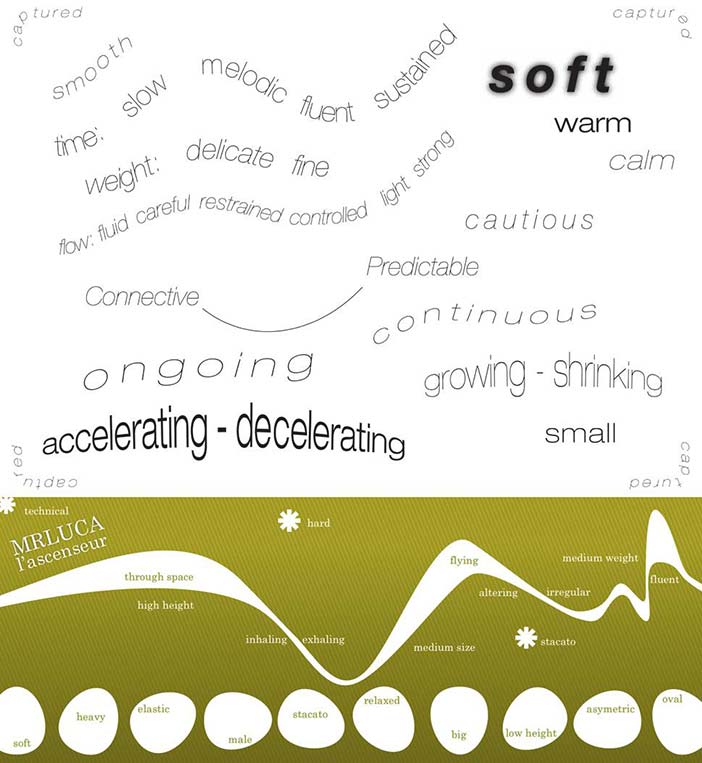
Author/Copyright holder: Unknown (pending investigation). Copyright terms and licence: Unknown (pending investigation). See section "Exceptions" in the copyright terms below.
Figure 6.26: Interaction Maps: Students abstracted the movies into interaction maps with keywords and graphics
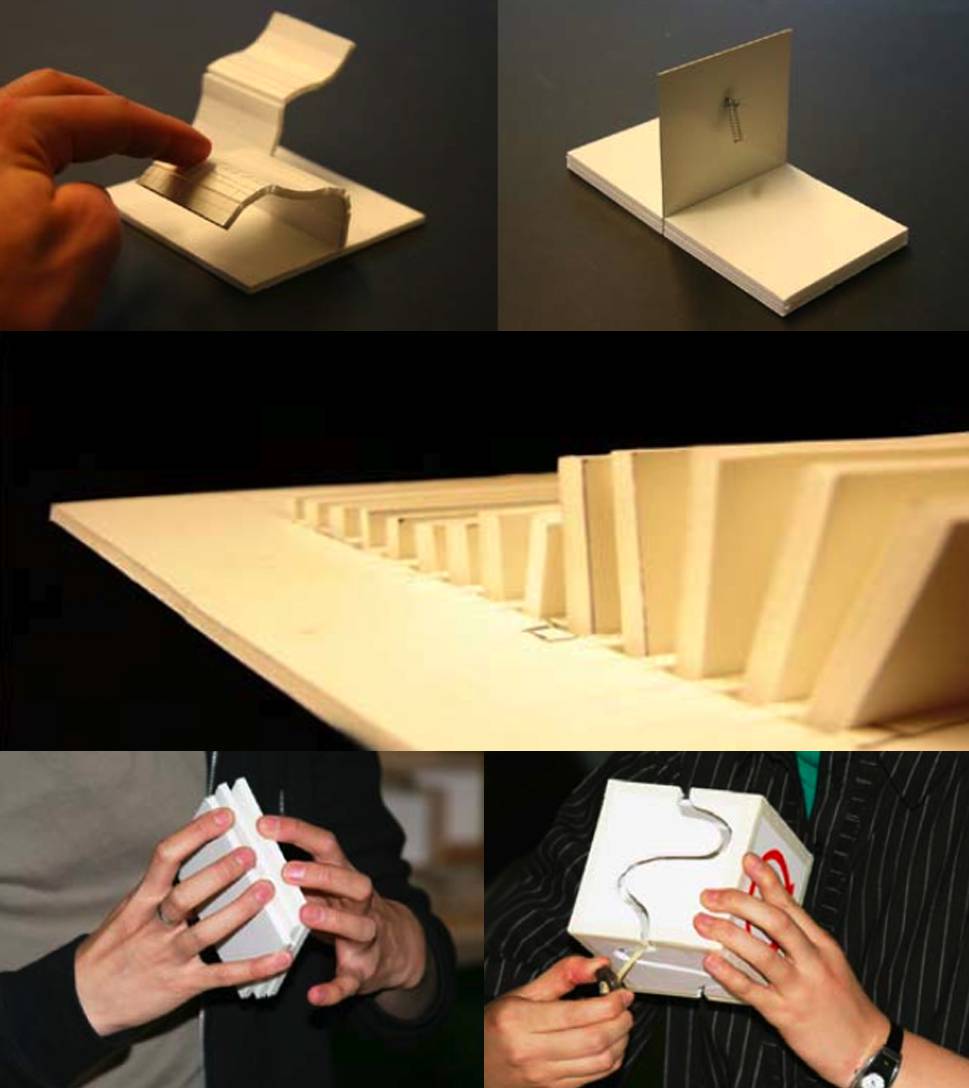
Author/Copyright holder: Unknown (pending investigation). Copyright terms and licence: Unknown (pending investigation). See section "Exceptions" in the copyright terms below.
Figure 6.27: Interaction Mechanisms: Students translated the keywords into interaction possibilities. They built interaction mechanisms with white 'neutral' foam board squares in order to focus on interaction instead of appearance (sensing and abstracting)
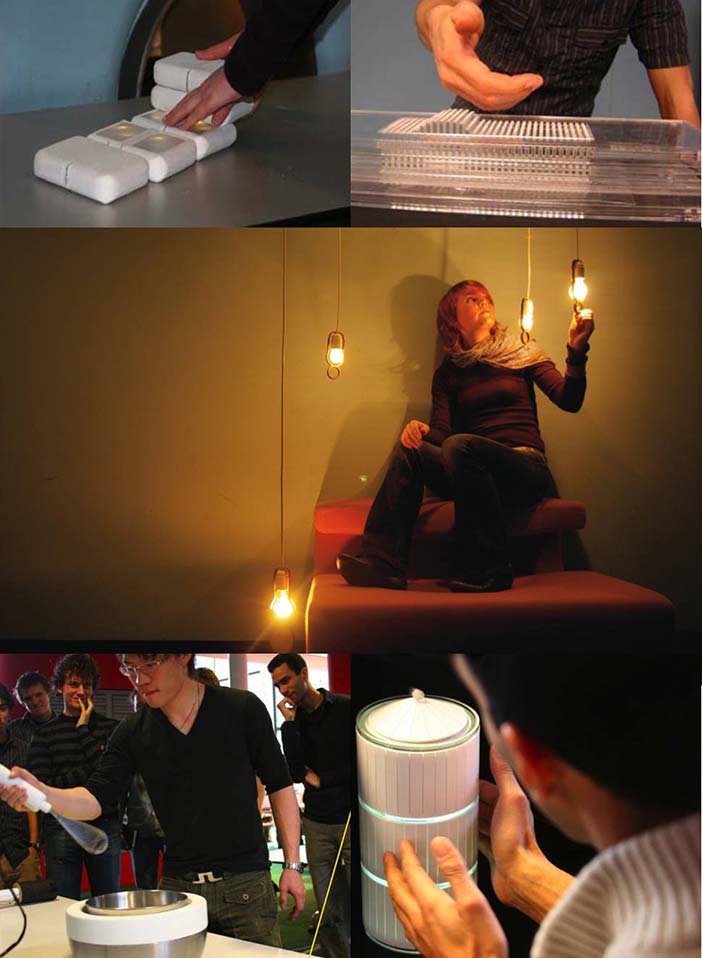
Author/Copyright holder: Unknown (pending investigation). Copyright terms and licence: Unknown (pending investigation). See section "Exceptions" in the copyright terms below.
Figure 6.28: Prototyping: Students built a prototype of a 'product' where the interaction had the same quality/experience potential as the music (cycles of doing and reflecting)
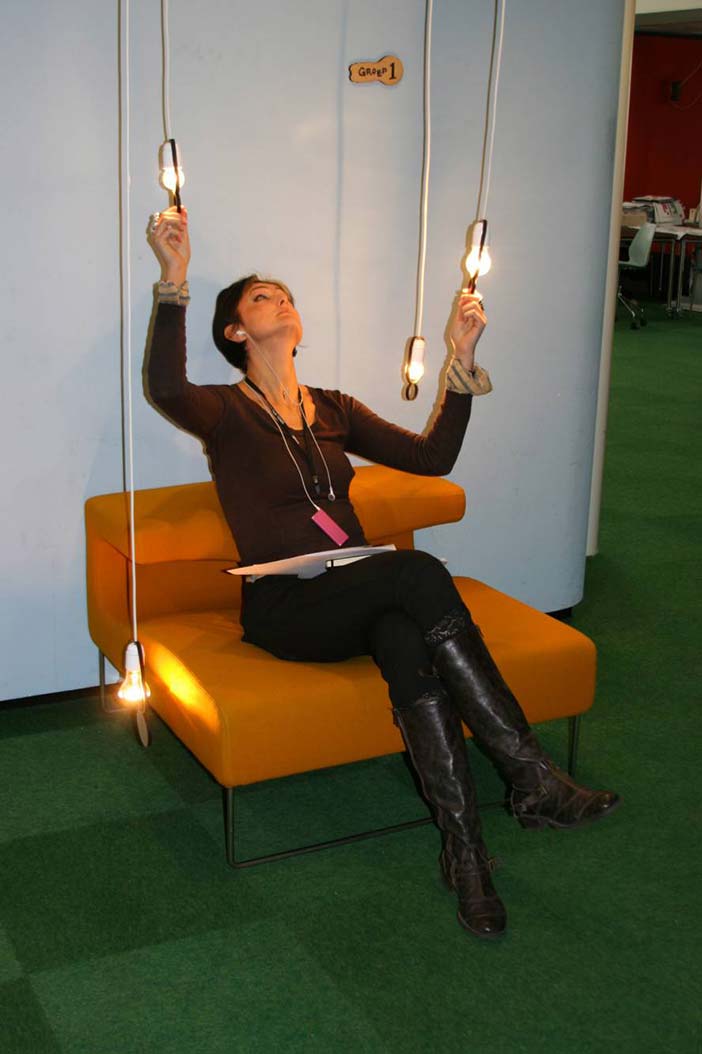
Author/Copyright holder: Unknown (pending investigation). Copyright terms and licence: Unknown (pending investigation). See section "Exceptions" in the copyright terms below.
Figure 6.29: Testing: In a matching experiment, which the students set up, participants were asked to listen to the music pieces and then choose the matching prototypes (analysing and abstracting). We consider this last step to be important to interweave design teaching and research.
In the ongoing debate about design research and about how to generate knowledge, we argue for an intertwining of the sensorial/intuitive and the analytical/abstract approach (Hummels and Frens, 2008). What we see as quintessential, though, is the primacy of doing, as we have also explained in the principle 'primacy of action'. We believe there is already too much abstraction in the world that is not abstracted from reality, but from the abstract, e.g. from language, words and abstract concepts. Therefore, we want our students to be able to move confidently between these two, but always on the basis of the experiential, the real (Hummels et al, 2009).
6.4.14.3 Related themes and research: 'first / third person perspective'
Points of view, including a first, second and third person perspective, is an essential element of phenomenology (see Part Three, Theoretical underpinning of industrial design). In her PhD work, Eva Deckers (to be published) uses a Research-through-Design approach to investigate if and how notions from the phenomenology of perception can inform design. Her approach is experimental phenomenology: the conditions for switching between first and third person are experimentally tested.
Deckers derives her inspiration from the work of Charles Lenay (2010). In his recent work, Lenay tries to understand the reasons for the pre-eminence of the tactile modality in descriptions of emotional exchanges. With the help of a minimalistic setup, he proposes a description of the essential conditions for 'contact' mediated by technical devices.

Author/Copyright holder: Unknown (pending investigation). Copyright terms and licence: Unknown (pending investigation). See section "Exceptions" in the copyright terms below.
Figure 6.30: The one-dimensional space of perceptual interaction: with a computer mouse, each subject moves a receptor field on a line in a shared digital space. When the two receptor fields encounter each other, each user receives a tactile stimulus on his free hand (Lenay, 2010).
In order to comprehend the relationship between such contact and emotional values, Lenay understands emotion as being the product of a force that instigates movement. He then shows that the 'force' which is transmitted in touching contacts is based on the duality of the perceiving body and the body image of the self. The fact that the subject is ignorant of his own body-image (he cannot see his face) is revealed by the breaking of perceptual symmetry on the occasion of a touching encounter. Charles Lenay's results provide some guiding principles for the design of interfaces and structures of interaction that allow for mediated emotional contact.
These principles challenged Eva Deckers to incorporate them into the design of intelligent systems. In her research, she shows how perceptive behaviour is omni-present in our daily life and how it can be applied to design perceptive behaviour in objects. The goal is to provide knowledge and tools to design products or systems that are capable of perceptive activity and that can engage in reciprocal interplay with the perceived world, including multiple users and multiple products. She shows that this interplay between person and artefact positively influences the person's feeling of involvement in their common space. She designed a rug, PeR, that follows the caress of one's hand by leaving a light trail. Any behaviour can be given to the light in the rug. For example, it can flee from your touch, but also follow you closely (Deckers et al, 2012; or see the video at http://dqi.id.tue.nl/per/PeR/Movie.html).

Author/Copyright holder: Unknown (pending investigation). Copyright terms and licence: Unknown (pending investigation). See section "Exceptions" in the copyright terms below.
Copyright status: Unknown (pending investigation). See section "Exceptions" in the copyright terms below.
Figure 6.31: PeR, Perception Rug, designed by Eva Deckers. PeR is a knotted carpet in which touch sensitivity and optic fibres are integrated. PeR has the ability to perceive and react to perceptive activity of people. PeR can adapt different perceptive behaviours.
Closely connected to PeR is a collection of sensual dynamics artifacts, developed by a group of Master students together with Pierre Levy, Eva Deckers, Michael Cruz (2012). These artifacts are able to sense a person and to behave upon it to invite for movements enhancing perceptive experience. Such an artifact is therefore the object of the experience, and at the same time the trigger for a greater sensory experience (see videos at http://dqi.id.tue.nl/sensual-dynamics/)
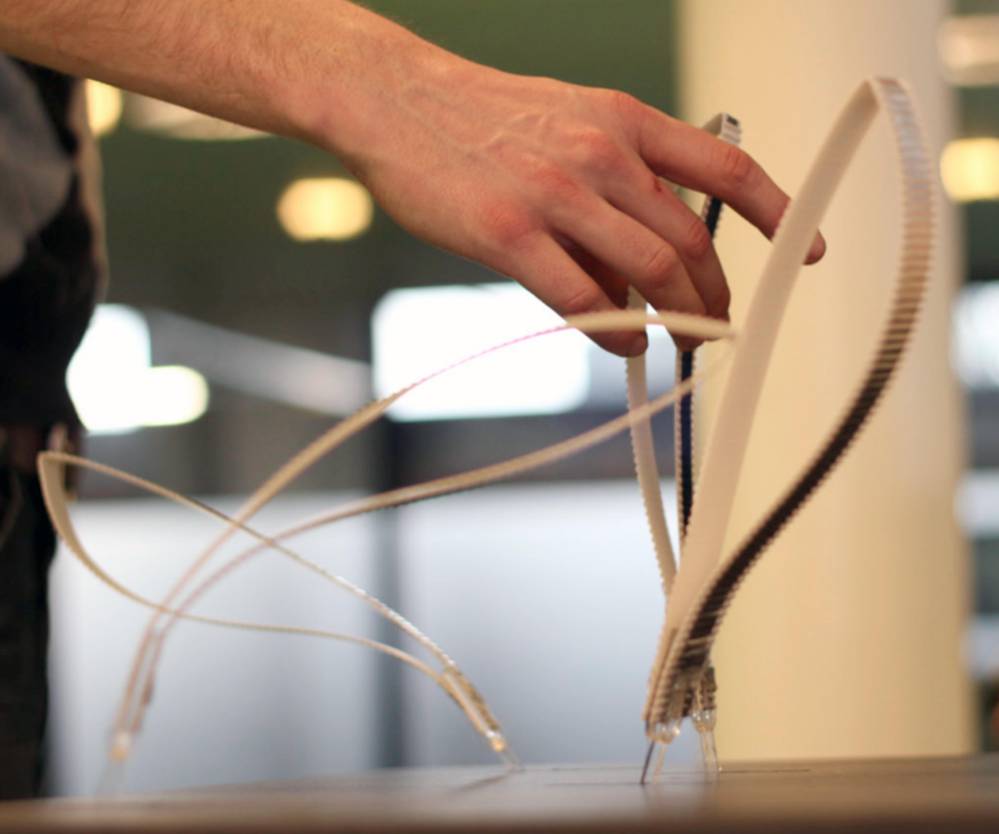
Author/Copyright holder: Unknown (pending investigation). Copyright terms and licence: Unknown (pending investigation). See section "Exceptions" in the copyright terms below.
Figure 6.32: Be Touched, designed by Josje Wijnen, Jurrian Tjeenk Willink, Kim van Iersel and Sebastiaan Pijnappel. When one of the bodies is touched on the front it moves forward, in the direction of your hand, and you are touched back. At the backside the body is more ticklish. The body immediately moves away from your touch. Also, when one of the bodies is being touched the other bodies will start moving to draw your attention: they also want to be touched.
When looking at other related themes and research that address the first / third person perspective, one can see that many of the theories and frameworks described in this chapter apply, such as pragmatism, reflective practice, constructivist learning, reflective transformative design and also research-through-design. Bart Hengeveld's proposition that the designer-researcher is preferably one and the same person, since users interact with his design rationale, emphasises the importance of the first person perspective, a concept which is generally detested in classical research where the researcher is the objective observer. Being one and the same person enables the designer-researcher to easily switch from a first to a third person perspective and vice versa.
6.4.15 Principle 7. Creating opportunities for transformation through subtlety
Design can create new perspectives and approaches, and allows for transformation. Design is about creating opportunities instead of solving problems. Designers use aesthetic subtlety to catalyse meaning creation in interaction. To do so, designers use ambiguity, uncertainty, open-endedness, and resistance. They take risks and dare to fail.
6.4.15.1 Example: The Other Brother
Designed by: John Helmes (Master graduate TU/e)
Project team: Abigail Sellen (Microsoft Research Cambridge (UK) Lab) and Caroline Hummels (TU/e)
Time frame: 2009
'The Other Brother' is a semi-autonomous device that captures images and video of spontaneous moments in the course of everyday life to enable people to re-experience these moments in a playful way. It uses more serendipitous, lightweight ways to capture moments instead of conventional photo and video cameras, which require a person to take the initiative and to control the framing of the shot, leading to somewhat predictable results (Helmes et al, 2009).
The Other Brother is the result of an iterative process using the RTD process (Hummels and Frens, 2011), starting from initial (interactive) sketches, concepts and physical explorations over several prototypes and ending in a final design that was tested several times for a few weeks in a home environment.

Author/Copyright holder: Unknown (pending investigation). Copyright terms and licence: Unknown (pending investigation). See section "Exceptions" in the copyright terms below.
Figure 6.33: The development of the Other Brother through at least three experienceable working prototypes
The project's goal was to design a disruptive innovative system in which disruptive refers to the absence of a well-established frame of reference for users, the market and society. Since disruptive innovations are open-ended and do not start with problem definition or finding, the system is all about creating opportunities for people to change their lives; opportunities through which a person can create meaning in a specific socio-cultural context. Since meaning is created in interaction between a person and an artefact, designers can 'merely' produce proposals for action and experience through their designed artefacts, while respecting people's perceptual-motor, social, emotional and cognitive skills.
Helmes tested the Other Brother in different families for one week in a row. The first test family existed of five people, a 50 year old father and mother, a 17 year old daughter and two sons, one aged 22 and the other 19. Initially, the father and mother of the family were quite sceptical about using the object since it was difficult for them to understand what exactly was being recorded and when. Since they really valued their privacy, their behaviour was not totally natural while the Other Brother was switched on. This is in strong contrast to the children, who did not experience any difficulty concerning privacy at all. Furthermore, the daughter seemed much more open to using the object in all kinds of different situations in comparison with her father. She also liked the fact that the Other Brother was on all the time and you simply did not pay any attention any more. This made the result very exciting since she did not know exactly what was captured. Another remarkable observation was the fact that she felt accompanied by the object while she spent an afternoon alone: "It was sociable, it made me feel not alone, I had something to talk to....I liked it staying with us for a whole week", she commented. In contrast to her father, she and her two brothers also intentionally triggered the Other Brother by making weird sounds or clapping their hands. As can been seen, the Other Brother was open enough for the children to explore new possibilities.
What is sometimes underestimated is the necessity of quality, subtlety and poetry of the design in interaction to catalyse meaning. Brewer et al (2007) state that the legibility/ambiguity tension concerns the extent to which a device is broadly understandable, but retains enough mystery both to be engaging and to allow users to project their own meanings onto it. We believe that design goes beyond pyramids, cubes and spheres, and beyond primary colours, which Brewer, Williams and Dourish used, and subsequently it will also be richer and even more effective.
Since products and systems are getting more intelligent, are taking more initiatives and seem at times to become 'part of the family' and thereby can (and probably will) transform society considerably, these developments require ethical discussion. Designers can be seen as catalysts for change by raising big societal questions as a way to transform society. In contrast to incremental changes, design can be used as inspiration for showing new ways, perspectives and approaches.
The goal of John Helmes' project was to envision and enable transformation. He deliberately used ambiguity, uncertainty and open-endedness in this design and design process. Throughout the several studies and workshops in the project, it became evident that the use of the Other Brother was emergent, i.e. its use was not prescribed by the designer — it simply emerged.
The project also surprised the client Microsoft Research Cambridge Lab: "By far the biggest surprise for us as a group was the realisation that the device itself appeared to have a life-like quality to it." Their responses clearly show that disruptive innovation, emergent behaviour and emergent interaction cannot be predicted or reasoned about beforehand. It is something that grows in interaction, while making, envisioning, testing, analysing, creating, etcetera in a real life context during the entire design process. Moreover, it requires a specific attitude from the designer using ambiguity, uncertainty, open-endedness, and resistance. The fact that Helmes took risks and dared to fail enabled this successful project.
6.4.15.2 Related themes and research
Transformation has become one of the buzzwords in design. In 2004, the British Design Council set up RED, a 'do tank' — as opposed to 'think tank' — that uses innovative design to tackle social and economic issues. They challenged accepted thinking and used creativity in close cooperation with users who were part of the design team to design new public services, systems and products that address social and economic problems. And they called their approach 'transformation design' (Burns et al, 2006).
Also in 2004, Matthijs van Dijk stated that the industry and, consequently, designers need to put more emphasis on true innovation based on a context-driven design strategy. Such a strategy evokes a paradigm shift by opening up and requiring a redefinition of the interaction between humans and products (Dijk van, 2004). Robert Fabricant, Vice President of Creative at Frog Design, sees a shift towards design with intent that has an immediate impact on user behaviour through direct social engagement (Fabricant, 2009). And Bruce Nussbaum, editor of the innovation and design coverage of Business Week, claimed that "'Innovation' is dead. Herald The Birth of 'Transformation' as The Key Concept for 2009". Nussbaum believes that transformation takes the best of design thinking and innovation and integrates them into a strategic guide for the unknowable and uncertain years ahead. He believes that we are already on the way to developing global networks working within ecosystems/ platforms (e.g. iTunes/iPod/iPhone, Nike Plus and Zipcar) that will make up our socio-economic and political worlds. Nussbaum considers transformation interesting because it approaches uncertainties with a methodology that creates options for new situations and sorts quickly through them for the best. It deals with a creative society in which we are all producers and consumers of value. Moreover, it can look at our systems — education, health-care, economic growth, transportation, defence, and political representation (Nussbaum, 2008).
6.4.16 6.4.7.2.1 Out of control
Designing for transformation requires specific design approaches based on open-endedness. It also requires enough self-confidence to design without having an idea of the solution space. It is about trusting one's intuition and senses (see principle 5), and as Sennett (2008) says, designing is about localising (making a matter concrete), questioning (reflecting on its quality) and opening up (expanding its sense). Designers should deliberately use ambiguity, uncertainty, open-endedness, complexity and resistance, and they should dare to fail. It is about being-out-of-control and being undisciplined, but still systematic during a creative, hands-on design process. This is essential for creating a complex unnatural (designed) world (Nelson, 1994). As we described earlier, development, both of products and of the designer himself, follows an equilibrium — disequilibrium — re-equilibrium pattern (Piaget, 1971). One goes from one stable state, equilibrium, to another, disequilibrium/chaos, and back to stability and order (re-equilibrium). The disequilibrium is the driving force of changing behaviour, transformation and development. Reflection and action are essential elements in regaining order because they can change ways of looking at the world and dealing with it. The re-equilibrium is a stable situation, but a design is never finished or right since the conditions, the situation and the user determine its status. So, designing is an activity that is highly iterative and dynamic.
Especially nowadays, when moving towards large living systems that are of a distributed, adaptable, evolvable, resilient and boundless nature, the number of variables and apparent connectivity become impossible to manage (Kelly, 1994). Moving towards such complexity implies that the challenges cannot be formulated exhaustively and that both challenges and solutions are not simply false or true; challenges are unique and there are multiple opportunities for solution spaces (Rittel, 1972). Consequently, designing complex systems can never be tackled through problem solving in a linear controlled process. Kelly (1994) states that the only way to develop or manage complex systems is by letting go of control and enabling the system to evolve without a central authority or imposed control mechanism. Although this last take might be too bold for many designers and even goes against the core of many design traditions, it stresses the need for an open process that supports evolving systems. According to Gilbert Cockton from Northumbria University (personal communication), this means that it cannot be based on an engineering approach (which starts from a problem), applied arts approach (which ignores the societal setting) or human-centred design approach (which is based on people's needs and wants).
6.4.17 6.4.7.2.2 New approaches in a transformation economy
We believe that our complex societal challenges require solutions that support people in changing their behaviour on a personal and societal level. Since the complexity of designing such systems, products and services has increased rapidly during the last decade, the need for collaboration among all the cross-disciplinary stakeholders is becoming paramount. Reon Brand and Simona Rocchi (Brand and Rocchi 2011) see this kind of collaboration at the core of a new emerging economy, i.e. the transformation economy, which is based upon our current knowledge economy. Our current economy revolves around knowledge and information, which comes in different forms, e.g. shared information and reviews from users on Internet, sensor data from networked appliances, and knowledge from experts. However, our major societal challenges are leading to a growing discomfort and quest for balance and sustainability that cannot be created on an individual level only, as is the case in the knowledge paradigm. It requires behavioural change on a societal level too, where the collective is more important than the individual. These trends will move our society towards the transformation paradigm in the future, where stakeholders work together on local solutions for local issues that stem from greater global issues (Gardien et al, 2012).
Collaboration within the transformation economy requires engagement and empathy. It requires respect based on a horizontal collaboration in which all stakeholders are equal, but not identical, and each valuable in their own way. It asks people to put themselves - their point of view, their value system, their experience and their skills - into the shared design space. Such a transformation economy requires new ways of organising and working together, new business and financial models and new legal constructions. Through fostering continued relationships with local partners over time, organisations become respected players in these value networks (Hummels, 2012).
For example, within the context of the Dutch Creative Industry Scientific Programme (CRISP 2011), Oscar Tomico, Martijn ten Bhömer and Kristi Kuusk are developing a value co-creation platform that supports the development of innovative Product Service Systems (PSS) in the context of smart textile services. In order to face the complexity of PSS, this platform aims to facilitate close collaboration between small and medium enterprises from Dutch textile and technology industry, service partners, creative hubs and universities (Bhömerten, 2012).
Moreover, designers need new approaches, tools and techniques to face our societal challenges. Since meaning is created in interaction, it is impossible to predict whether the resulting outcome of designing for radical innovation will realise long-term societal change. Therefore, we have taken the design process into everyday life, involving a large group of stakeholders, including citizens in their everyday environment, thus realising valuable propositions together. To do this we have created Experiential Design Landscapes (EDL), infrastructures in neighbourhoods where all stakeholders work together, creating experienceable propositions with citizens, which evolve over time. These propositions, Experiential Probes (EP), are open, sensor-enhanced, networked products-service systems that enable citizens to develop new and emerging behaviour and, in parallel, enable detailed analysis of the emerging data patterns by researchers and designers as a source of inspiration for the development of future systems, products and services (Gent et al, 2011; Megens et al, 2012). This method is highly suitable for use within a transformation economy.
6.4.17.1 Future directions of industrial design
The field of industrial design is changing. That is the message when going to conferences such as TED, the World Design Forum (WDF), ICSID World Design Congress and CHI. According to Stefano Marzano, CEO of Philips Design, we are moving towards a new intellectual renaissance based on humanistic values. Designers are catalysts for change and raise large societal questions (Marzano, 2010). Consequently, the scope of design is changing. It is expanding towards all kind of systems: education, health-care, economic growth, transportation, defence, and political representation. Moreover, the role of designers is changing. Designers are dealing with a creative society in which we are all producers and consumers of value (Nussbaum, 2008).
As stated at the beginning of this chapter, industrial design is concerned with mass production in factories for the broadest market possible. However, given the developments in technology and society, mass production has extended to mass customisation, using new production techniques, and the broadest market possible has moved towards a diverse, global society that is no longer based on passive consumers; a society in which people are becoming accomplices in a never-ending design process of highly dynamic, adaptive and intelligent systems, products and services.

Author/Copyright holder: Bart van Overbeeke Fotografie. Copyright terms and licence: All Rights Reserved. Reproduced with permission. See section "Exceptions" in the copyright terms below.
Figure 6.34: One example of the shift from mass production to mass customisation is a custom-made headphone made by Brian Garret (http://briangarret.com) for his Master graduation project (coached by Joep Frens, TU/e)
We see a desire for design-driven innovation; that is, we step away from incremental innovation in favour of disruptive innovation, in which disruptive refers to the absence of a well-established frame of reference for users or the market. Not only is the product as such new, but it also enables the creation of radical new meaning for the user, the market and society. The field is moving towards designing open and intelligent systems that evolve during use and have a high level of complexity due to their adaptive, context-dependent and highly dynamic character. Alongside this development, the role of the designer is changing. More and more we see open platforms and design projects in which a variety of people and experts create products. Finally, we see a changing attitude towards growth and development, towards self-directed learning and continuous development as a design professional.
Many question the appropriateness of the term 'industrial design' for this emerging field of expertise. However, since meaning is created in interaction, the concept of industrial design is also dynamic and changing. So, instead of changing its name, we believe we should explore the potential of industrial design, as we have tried to do over the last twenty years and have documented in this chapter.
6.5 Acknowledgements
The work described in this chapter is based on well over twenty-five years of design research and education, and it has been - and is still - a group effort. Therefore, we would like to thank all our friends from the Designing Quality in Interaction group at Eindhoven University of Technology, as well as our national and international friends, colleagues, students and alumni with whom we collaborated closely to develop these principles of industrial design.
6.6 References
(1990): Technology and the Lifeworld : From Garden to Earth.
Achterhuis, Hans (1997): Van Stoommachine tot cyborg; denken over techniek in de nieuwe wereld. Ambo
Anderson, Lorin W. and Krathwohl, David R. (2000): A Taxonomy for Learning, Teaching, and Assessing: A Revision of Bloom's Taxonomy of Educational Objectives, Abridged Edition. Pearson
Archer, Bruce (1995): The Nature of Research. In Journal of Co-Design,
Baker, Robin (1993): Designing the Future: The Computer in Architecture and Design. Thames and Hudson
Bartneck, Christoph and Rauterberg, Matthias (2007): HCI reality -- an 'Unreal Tournament'?. In International Journal of Human-Computer Studies, 65 (8) pp. 737-743
Bhöme, Martijn ten, Tomico, Oscar, Kleinsmann, Maaike, Kuusk, Kristi and Wensveen, Stephan (2012): Designing Smart Textile Services through value networks, team mental models and shared ownership. In: Service design and innovation conference ServDes. 2012 8-10 February, 2012, Espoo, Finland. pp. 1-10
Bijker, Wiebe E. and Law, John (eds.) (1994): Shaping Technology / Building Society: Studies in Sociotechnical Change (Inside Technology). The MIT Press
Birenbaum, Menucha (2003): New Insights Into Learning and Teaching and Their Implications for Assessment. In:Segers, Mien, Dochy, F. and Cascallar, E. (eds.). "Optimising New Modes of Assessment: In Search of Qualities and Standards (Innovation and Change in Professional Education)". Springer
Bos, Maarten W., Baaren, Rick B. van, Nordgren, Loran F. and Dijksterhuis, Ap (2006): Making choices without deliberation. In Science, 312 (5779) pp. 1472-1472
Brand, Reon and Rocchi, Simona (2011). Rethinking value in a changing landscape; a model for strategic reflection and business transformation. Retrieved 9 November 2012 from design.philips.com: http://www.design.philips.com/philips/shared/asset...
Brewer, Johanna, Williams, Amanda and Dourish, Paul (2007): A handle on what's going on: combining tangible interfaces and ambient displays for collaborative groups. In: Ullmer, Brygg and Schmidt, Albrecht (eds.)Proceedings of the 1st International Conference on Tangible and Embedded Interaction 2007, Baton Rouge, Louisiana, USA, February 15-17, 2007 2007. pp. 3-10
Burdek, Bernhard E. (2005): Design: The History, Theory and Practice of Product Design. Birkhäuser Architecture
Burns, Colin, Cottam, Hilary, Vanstone, Chris and Winhall, Jennie (2006). Red paper 02; Transformation Design. Retrieved 9 November 2012 from Designcouncil.info: http://www.designcouncil.info/mt/RED/transformatio...
Buur, Jacob, Jensen, Mads Vedel and Djajadiningrat, Tom (2004): Hands-only scenarios and video action walls: novel methods for tangible user interaction design. In: Proceedings of DIS04: Designing Interactive Systems: Processes, Practices, Methods, & Techniques 2004. pp. 185-192
Coker, William and Shook, Jan (2006): Increasing the appeal of AAC technologies using VSD's in preschool language intervention. In: Proceedings of the 22nd Annual International Technology and Persons with Disabilities Conference 19-24 March, 2006, Los Angeles, USA.
Coyne, Richard and Snodgrass, Adrian (1993): Cooperation and individualism in design. In Environment and planning B, 20 (2) p. 163–174
Cross, Nigel (2011): Design Thinking: Understanding How Designers Think and Work. Berg Publishers
Cross, Nigel, Christiaans, Henri and Dorst, Kees (eds.) (1996): Analysing Design Activity. London, Wiley
Deckers, Eva, Levy, Pierre, Wensveen, Stephan, Ahn, Rene and Overbeeke, Kees (2012): Designing for perceptual crossing: applying and evaluating design notions. In International Journal of Design, 6 (3)
Dewey, John (1934): Art as Experience. Perigee Trade
Dewey, John (1997): Experience And Education. Free Press
Dijk, Jelle van (2012). Sharing traces, making sense: How interactive technology shapes embodied cognitive group practices – and vice versa. University of Technology Eindhoven
Dijksterhuis, Ap, Bos, Maarten W., Nordgren, Loran F and Baaren, Rick B. van (2006b): On making the right choice: the deliberation-without-attention effect. In Science, 311 (5763) pp. 1005-1007
Dijksterhuis, Ap, Bos, Maarten W., Nordgren, Loran F. and Baaren, Rick B. van (2006c): Complex choices better made unconsciously?. In Science, 313 pp. 760-761
Dijksterhuis, Ap, Bos, Maarten W., Nordgren, Loran F. and Baaren, Rick B. van (2006a): Making choices without deliberation. In Science, 312 p. 1472
Djajadiningrat, J. P., Overbeeke, Kees and Wensveen, Stephan (2000): Augmenting fun and beauty: a pamphlet. In:Designing Augmented Reality Environments 2000 2000. pp. 131-134
Djajadiningrat, Tom, Wensveen, Stephan, Frens, Joep and Overbeeke, Kees (2004): Tangible Products: redressing the balance between appearance and action. In Personal and Ubiquitous Computing, 8 (5) pp. 294-309
Djajadiningrat, Tom, Matthews, Ben and Stienstra, Marcelle A. (2007): Easy doesn't do it: skill and expression in tangible aesthetics. In Personal and Ubiquitous Computing, 11 (8) pp. 657-676
Doll, William E. (1986): Prigogine: A New Sense of Order, A New Curriculum. In Theory into Practice, 25 (1) pp. 10-16
Dourish, Paul (2001): Where the Action Is: The Foundations of Embodied Interaction. MIT Press
Dunne, Anthony and Raby, Fiona (2001): Design Noir: The Secret Life of Electronic Objects. Birkhäuser Science
Fabricant, Robert (2009). Design with intent. How designers can influence behavior. Retrieved 11 November 2012 from Designmind.frogdesign.com: http://designmind.frogdesign.com/articles/power/de...
Fabricant, Robert (2009a): Project Masiluleke. In Interactions, 16 (6) pp. 6-12
Fitzmaurice, George W., Ishii, Hiroshi and Buxton, Bill (1995): Bricks: Laying the Foundations for Graspable User Interfaces. In: Katz, Irvin R., Mack, Robert L., Marks, Linn, Rosson, Mary Beth and Nielsen, Jakob (eds.)Proceedings of the ACM CHI 95 Human Factors in Computing Systems Conference May 7-11, 1995, Denver, Colorado. pp. 442-449
Forlizzi, Jodi and Battarbee, Katja (2004): Understanding experience in interactive systems. In: Proceedings of DIS04: Designing Interactive Systems: Processes, Practices, Methods, & Techniques 2004. pp. 261-268
Forty, Adrian (1986): Objects of Desire: Design and Society Since 1750. Thames and Hudson
Frens, Johannes W. (2006). Designing for rich interaction: Integrating form, interaction and function. Industrial Design-University of Technology Eindhoven http://alexandria.tue.nl/extra2/200610381.pdf
Gardien, Paul, Djajadiningrat, Tom, Hummels, Caroline and Brombacher, Aarnout C. (2012): Innovation paradigms: how design needs to evolve to deliver value. In International Journal of Design, 6 (3)
Gaver, William W. (1991): Technology Affordances. In: Robertson, Scott P., Olson, Gary M. and Olson, Judith S. (eds.) Proceedings of the ACM CHI 91 Human Factors in Computing Systems Conference April 28 - June 5, 1991, New Orleans, Louisiana. pp. 79-84
Gent, Sabine van, Hummels, Caroline, J.P.G.Megens, Carl, Peeters, Michel, Lu, Yuan and Brombacher, Aarnout C. (2011): Experiential Design Landscapes as a design tool for market research of disruptive intelligent systems. In:Best, Kathryn, Bruce, Margaret, Buijs, Jan, Cooper, Rachel and Gemser, Gerda (eds.) Proceedings of the 1st Cambridge Academic Design Management Conference September 7-8, 2011, Cambridge, United Kingdom .
Gibson, James J. (1979): The Ecological Approach to Visual Perception. New Jersey, USA, Lawrence Erlbaum Associates
Heidegger, Martin (1962): Being and Time. English translation 1962.
Heidegger, Martin (1927): Being and Time. Harper Perennial Modern Classics
Helmes, John, Hummels, Caroline and Sellen, Abigail (2009): The other brother: re-experiencing spontaneous moments from domestic life. In: Villar, Nicolas, Izadi, Shahram, Fraser, Mike and Benford, Steve (eds.) TEI 2009 - Proceedings of the 3rd International Conference on Tangible and Embedded Interaction February 16-18, 2009, Cambridge, UK. pp. 233-240
Hengeveld, Bart J. (2011). Designing LinguaBytes : a tangible language learning system for non- or hardly speaking toddlers. University of Technology Eindhoven http://alexandria.tue.nl/extra2/715535.pdf
Heskett, John (1980): Industrial Design (World of Art Series). W W Norton and Co Inc
Hine, Thomas (1986): Populuxe. Overlook TP
Horn, Richard (1985): Memphis: Objects, Furniture and Patterns. Simon and Schuster (Paper)
Hummels, Caroline (2000b). Evoke experiences through engagement. Technical University Delft http://dqi.id.tue.nl/docs/Hummels2000.pdf
Hummels, Caroline (2000a). Gestural design tools: prototypes, experiments and scenarios. Delft University of Technology http://id-dock.com/pages/overig/caro/publications/thesis/00Humthesis.pdf
Hummels, Caroline (2012). Matter of transformation: sculpting a valuable tomorrow. Retrieved 11 November 2012 from University of Technology Eindhoven: http://dqi.id.tue.nl/docs/Inaugural_Lecture-Caroli...
Hummels, Caroline (2007): Searching for Salient Aspects of Resonant Interaction. In Knowledge Technology Policy, 20 (1) pp. 19-29
Hummels, Caroline and Frans, Joep W. (2008): Designing for the unknown: a design process for the future generation of highly interactive systems and products,. In: Proceedings of the 10th International Conference on Engineering and Product Design Education 2008. pp. 204-209
Hummels, Caroline and Frens, Joep (2009): The reflective transformative design process. In: Proceedings of ACM CHI 2009 Conference on Human Factors in Computing Systems 2009. pp. 2655-2658
Hummels, Caroline and Frens, Joep W. (2008): Designing for the unknown: A design process for the future generation of highly interactive systems and products. In Reflective Practice, 4 (0) pp. 1-6
Hummels, Caroline and Frens, Joep (2011): Designing Disruptive Innovative Systems, Products and Services: RTD Process. In: Coelho, Denis (ed.). "Industrial Design-New Frontiers". Rijeka, Croatia: InTechpp. 145-172
Hummels, Caroline and Overbeeke, Kees (2010): Special Issue Editorial: Aesthetics of Interaction. In International Journal of Design, 4 (2) pp. 1-2
Hummels, Caroline and Vinke, Diana (2009): Eindhoven designs; volume two: Developing the competence of designing intelligent systems. Eindhoven, The Netherlands, University of Technology Eindhoven
Hummels, Caroline, Overbeeke, Kees and Klooster, Sietske (2007): Move to get moved: a search for methods, tools and knowledge to design for expressive and rich movement-based interaction. In Personal and Ubiquitous Computing, 11 (8) pp. 677-690
Hummels, Caroline, Restrepo, Michael Cruz and Overbeeke, Kees (2009): Designing the melody of interaction through movies, maps, mechanisms, prototypes and presentations. In: Proceedings of ACM CHI 2009 Conference on Human Factors in Computing Systems 2009. pp. 2647-2650
Ihde, Don (1990): Technology and the Lifeworld: From Garden to Earth (Indiana Series in the Philosophy of Technology). Indiana University Press
Ishii, Hiroshi and Ullmer, Brygg (1997): Tangible Bits: Towards Seamless Interfaces between People, Bits and Atoms. In: Pemberton, Steven (ed.) Proceedings of the ACM CHI 97 Human Factors in Computing Systems ConferenceMarch 22-27, 1997, Atlanta, Georgia. pp. 234-241
ISO standard 9241, Ergonomic requirements for office work with visual display terminals.
Kelly, Kevin (1994): Out of Control: The New Biology of Machines, Social Systems, & the Economic World. Basic Books
Kint, Johanna (2001): Expo 58 als belichaming van het humanistisch modernisme. 010
Kint, Johanna M. L., Overbeeke, Kees J. and Ross, Philip (2010): D'ou venons nous? Que sommes nous? Ou allons nous?. In: Aoussat, Ameziane, Shiizuka, Hisao and Chen, Kuohsiang (eds.) International Conference on Kansei Engineering and Emotion Research March 2-4, 2010, Paris, France.
Koskinen, Ilpo, Zimmerman, John, Binder, Thomas, Redstrom, Johan and Wensveen, Stephan (2011): Design Research Through Practice: From the Lab, Field, and Showroom. Morgan Kaufmann
Kyffin, Steven, Feijs, Loe and Djajadiningrat, Tom (2005): Exploring expression of form, action, and interaction. In:Sloane, Andy (ed.). "Home-Oriented Informatics and Telematics: Proceedings of the IFIP WG 9.3 HOIT2005 Conference (IFIP Advances in Information and Communication Technology)". Springer
Latour, Bruno (1994): Where are the missing masses? The sociology of a few mundane artifacts. In: Bijker, Wiebe E. and Law, John (eds.). "Shaping Technology / Building Society: Studies in Sociotechnical Change (Inside Technology)". The MIT Press
Lawson, Bryan (2005): How Designers Think, Fourth Edition: The Design Process Demystified. Architectural Press
Lawson, Bryan and Dorst, Kees (2009): Design Expertise. Taylor and Francis
Lenay, Charles (2010): It's So Touching: Emotional Value in Distal Contact. In International Journal of Design, 4 (2) pp. 15-25
Locher, Paul, Overbeeke, Kees and Wensveen, Stephan A. G. (2010): Aesthetic Interaction: A Framework. In Design Issues, 26 (2) pp. 70-79
Maeda, John (ed.) (1999): Design by Numbers. The MIT Press
Marti, Patrizia and Overbeeke, Kees (C. J.) (2011): Designing complexity in context: Light through Culture. In:Proceedings of the 9th ACM SIGCHI Italian Chapter International Conference on Computer-Human Interaction Facing Complexity 2011. pp. 65-70
Marzano, Stefano (2011). The next design. Retrieved 12 November 2012 from worlddesignforum.nl: http://www.worlddesignforum.nl/?p=15
Megens, Carl J. P. G., Peeters, Michel M. R., Hummels, Caroline and Brombacher, Aarnout C. (2012): Designing experiential probes for the wild. In ACM Transactions on Computer-Human Interaction,
Merleau-Ponty, Maurice (1958): Phenomenology of Perception. London, England, Routledge
Merleau-Ponty, Maurice (1962): Phenomenology of Perception: An Introduction. Routledge
Michaels, Claire F. and Carello, Claudia (1981): Direct Perception. Prentice Hall
Nelson, Harold G. (1994): The Necessity of Being "Un-Disciplined" and "Out-of-Control": Design Action and Systems Thinking. In Performance Improvement Quarterly, 7 (3) pp. 22-29
Norman, Donald A. (1988): The Psychology of Everyday Things. New York, Basic Books
Nussbaum, Bruce (2008). "Innovation" is Dead. Herald The Birth of "Transformation" as The Key Concept for 2009. Retrieved 1 August 2011 from BusinessWeek: http://www.businessweek.com/innovate/NussbaumOnDes...
Nussbaum, Bruce (2008). "Innovation" is dead. Herald the birth of "transformation" as the key concept for 2009. Retrieved 13 November 2012 from Businessweek.com: http://www.businessweek.com/stories/2008-12-30/inn...
Overbeeke, Kees (2007). The aesthetics of the impossible. Inaugural lecture, October 26, 2007. Eindhoven University of Technology http://dqi.id.tue.nl/docs/Inaugural_Lecture-Kees_Overbeeke-2007.pdf
Overbeeke, Kees and Wensveen, Stephan (2003): From perception to experience, from affordances to irresistibles. In:DPPI 2003 - Proceedings of the 2003 International Conference on Designing Pleasurable Products and Interfaces June 23-26, 2003, Pittsburgh, PA, USA. pp. 92-97
Overbeeke, Kees, Djajadiningrat, Tom, Hummels, Caroline and Wensveen, Stephan (2002): Beauty in usability: Forget about ease of use!. In: Green, William S. and Jordan, Patrick W. (eds.). "Pleasure with Products: Beyond Usability". CRC Press
Overbeeke, Kees, Wensveen, Stephan A. G. and Hummels, Caroline (2006): Design research: generating knowledge through doing. In: Michel, Ralf and Hirt, Lysianne L. (eds.) Drawing new territories; best of design research, 3rd symposium of design research 17-18 November, 2006, Geneva, Switzerland . pp. 51-69
Petersen, Marianne Graves, Iversen, Ole Sejer, Krogh, Peter Gall and Ludvigsen, Martin (2004): Aesthetic interaction: a pragmatist's aesthetics of interactive systems. In: Proceedings of DIS04: Designing Interactive Systems: Processes, Practices, Methods, & Techniques 2004. pp. 269-276
Philips, Philips (1996): Vision of the future. Philips
Piaget, Jean (1971): Biology and Knowledge. University of Chicago Press
Rittel, Horst W. J. (1972): On the planning crisis: Systems analysis of the 'first and second generations'. InBedriftsøkonomen, 8 pp. 390-396
Ross, Philip (2008). Ethics and aesthetics in intelligent product and system design. University of Technology Eindhoven http://www.idemployee.id.tue.nl/p.r.ross/thesis/Ethics%20and%20aesthetics%20site/Home_files/Ross-thesis.pdf
Sanders, John T. (1997): An ontology of affordances. In Ecological psychology, 9 (1) pp. 97-112
Schwartz, Shalom H. (1992): Universals in the content and structure of values: Theory and empirical tests in 20 countries. In: Zanna, Mark (ed.). "Advances in experimental social psychology". New York, USA: Academic Presspp. 1-65
Schwartz, Shalom H. (2004): Basic human values: Their content and structure across countries. In: Porto, Juliana B. and Tamayo, Álvaro (eds.). "Valores de trabalho [Values and work]". Universidad de Brasil
Schön, Donald A. (1983): The Reflective Practitioner: How Professionals Think In Action. Basic Books
Sennett, Richard (2008): The Craftsman. Yale University Press
Shaer, Orit and Hornecker, Eva (2010): Tangible User Interfaces: Past, Present, and Future Directions. InFoundations and Trends in Human-Computer Interaction, 3 (1) pp. 1-137
Shusterman, Richard (2008): Body Consciousness: A Philosophy of Mindfulness and Somaesthetics. Cambridge University Press
Shusterman, Richard (2000): Pragmatist Aesthetics: Living Beauty, Rethinking Art. Rowman and Littlefield Publishers, Inc
Smets, Gerda and Overbeeke, Kees (1994): Industrial design engineering and the theory of direct perception. InDesign Studies, 15 (2) pp. 175-184
Snow, Catherine E. and Ferguson, Charles A. (eds.) (1977): Talking to Children: Language Input and Acquisition.Cambridge University Press
Sparke, Penny (1996): An Introduction to Design and Culture: 1900 to the Present. Routledge
Sparke, Penny (1986): An Introduction to Design and Culture: 1900 to the Present. Allen and Unwin
Stappers, Pieter J. (2007): Doing design as a part of doing research. In: Michel, Ralf (ed.). "Design research now: Essays and selected projects". Basel, Switzerland: Birkhäuserpp. 81-91
Stienstra, Jelle T., Bruns, Miguel, Wensveen, Stephan A. G. and Kuenen, Stoffel D. (2012): How to design for transformation of behavior through interactive materiality. In: Proceedings of the 7th Nordic Conference on Human-Computer Interaction NordiCHI 2012 October 14-17, 2012, Copenhagen, Denmark.
Stienstra, Jelle, Overbeeke, Kees and Wensveen, Stephan (2011): There is More in a Single Touch: Mapping the Continuous to the Discrete. In: Overbeeke, Kees (ed.) CHItaly Proceedings of the 9th ACM SIGCHI Italian Chapter International Conference on Computer-Human Interaction Facing Complexity 2011. pp. 27-32
Stolterman, Erik (2008): The nature of design practice and implications for interaction design research. InInternational Journal of Design, 2 (1) pp. 55-65
Title: Principes Author: Marten van Dijk Publication: Inaugural speech Year: 2004 Publisher: Delft University of Technology
Tomasello, Michael (2003): Constructing a Language: A Usage-Based Theory of Language Acquisition. Harvard University Press
Trotto, Ambra, Hummels, Caroline and Restrepo, Michael Cruz (2011): Towards design-driven innovation: designing for points of view using intuition through skills. In: Proceedings of Designing Pleasurable Products and Interfaces 2011, Milano. pp. 3-10
Verbeek, Peter P. (2006): Materializing morality – Design ethics and technological mediation. In Science, Technology and Human Values, 31 (3) pp. 361-380
Wakkary, Ron (2005): Framing complexity, design and experience: a reflective analysis. In Digital Creativity, 16 (2) pp. 65-78
Weiser, Mark (1991): The Computer for the 21st Century. In Scientific American, 265 (3) pp. 94-104
Wensveen, S. A. G., Djajadiningrat, J. P. and Overbeeke, Kees (2004): Interaction frogger: a design framework to couple action and function through feedback and feedforward. In: Proceedings of DIS04: Designing Interactive Systems: Processes, Practices, Methods, & Techniques 2004. pp. 177-184
Zimmerman, John, Forlizzi, Jodi and Evenson, Shelley (2007): Research through design as a method for interaction design research in HCI. In: Proceedings of ACM CHI 2007 Conference on Human Factors in Computing Systems2007. pp. 493-502

